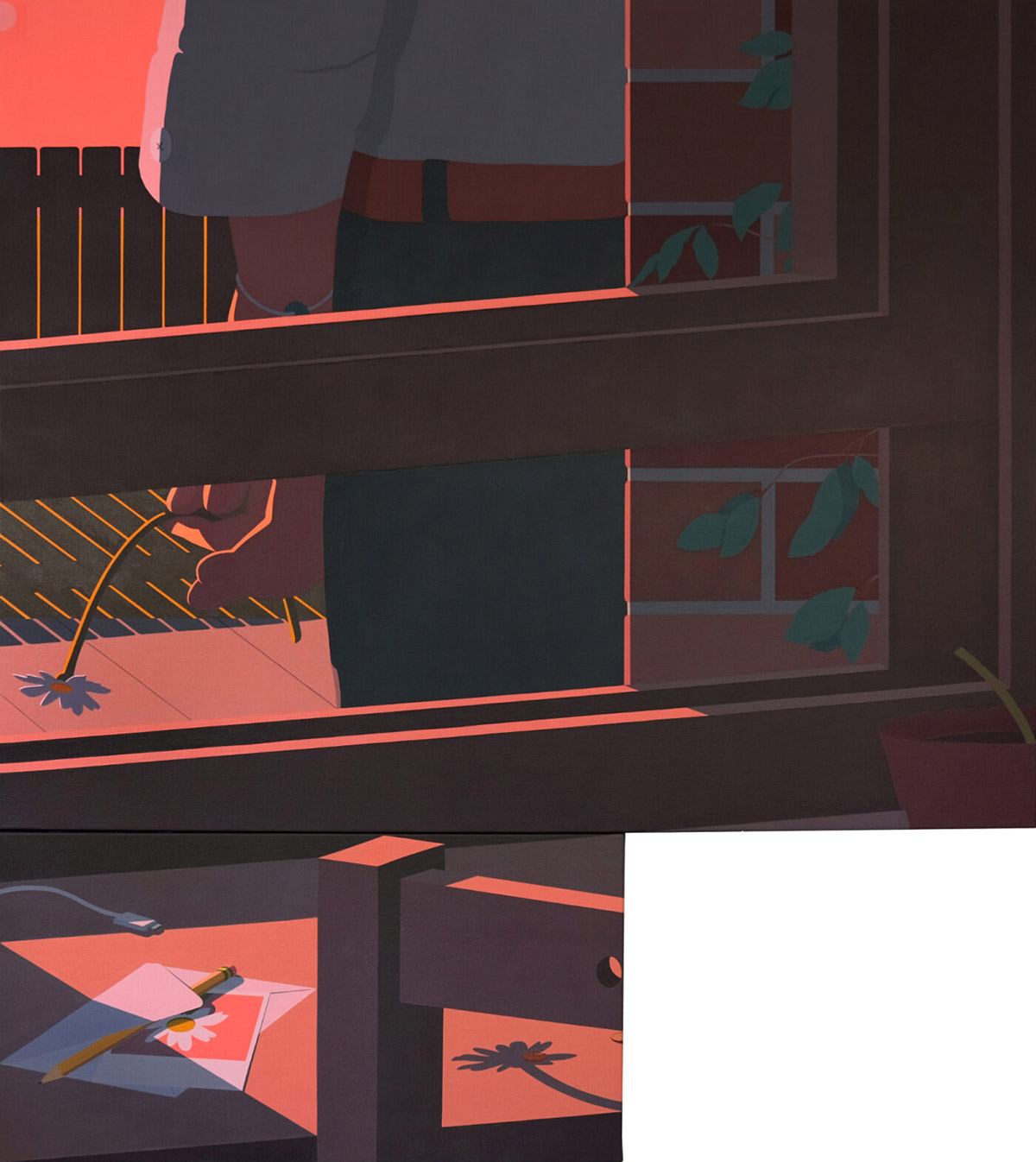Recent CPAN uploads - MetaCPAN: DateTime-Format-Genealogy-0.06
Create a DateTime object from a Genealogy Date
Changes for 0.06 - 2024-04-23T08:28:40Z
- Handle entries which have the French 'Mai' instead of the English 'May' Some messages were printed even in quiet mode Handle '1517-05-04' as '04/05/1517'
OCaml Weekly News: OCaml Weekly News, 23 Apr 2024
- A second beta for OCaml 5.2.0
- An implementation of purely functional double-ended queues
- Feedback / Help Wanted: Upcoming OCaml.org Cookbook Feature
- Picos — Interoperable effects based concurrency
- Ppxlib dev meetings
- Ortac 0.2.0
- OUPS meetup april 2024
- Mirage 4.5.0 released
- patricia-tree 0.9.0 - library for patricia tree based maps and sets
- OCANNL 0.3.1: a from-scratch deep learning (i.e. dense tensor optimization) framework
- Other OCaml News
Recent additions: bearriver 0.14.8
FRP Yampa replacement implemented with Monadic Stream Functions.
Recent additions: dunai-test 0.12.3
Testing library for Dunai
Recent additions: dunai 0.12.3
Generalised reactive framework supporting classic, arrowized and monadic FRP.
Recent CPAN uploads - MetaCPAN: Error-Show-v0.4.0
Show context around syntax errors and exceptions
Changes for v0.4.0 - 2024-04-23
- fixes
- new features
- improvements
- other
Hackaday: Your Smart TV Does 4K, Surround Sound, Denial-of-service…

Any reader who has bought a TV in recent years will know that it’s now almost impossible to buy one that’s just a TV. Instead they are all “smart” TVs, with an on-board computer running a custom OS with a pile of streaming apps installed. It fits an age in which linear broadcast TV is looking increasingly archaic, but it brings with it a host of new challenges.
Normally you’d expect us to launch into a story of privacy invasion from a TV manufacturer at this point, but instead we’ve got [Priscilla]’s experience, in which her HiSense Android TV executed a denial of service on the computers on her network.
The root of the problem appears to be the TV running continuous network discovery attempts using random UUIDs, which when happening every few minutes for a year or more, overloads the key caches on other networked machines. The PC which brought the problem to light was a Windows machine, which leaves us sincerely hoping that our Linux boxen might be immune.
It’s fair to place this story more under the heading of bugs than of malicious intent, but even so it’s something that should never have made it to production. The linked story advises nobody to buy a HiSense TV, but to that we’d have to doubt that other manufactures wouldn’t be similarly affected.
Header: William Hook, CC-BY-SA 2.0.
Thanks [Concretedog] for the tip.
Recent additions: haskoin-store 1.5.1
Storage and index for Bitcoin and Bitcoin Cash
Recent CPAN uploads - MetaCPAN: XS-Parse-Keyword-0.40
XS functions to assist in parsing keyword syntax
Changes for 0.40 - 2024-04-23
- CHANGES
- BUGFIXES
Recent CPAN uploads - MetaCPAN: Syntax-Operator-Zip-0.10
infix operator to compose two lists together
Changes for 0.10 - 2024-04-23
- CHANGES
Recent additions: hspec-meta 2.11.8
A version of Hspec which is used to test Hspec itself
Slashdot: NASA Officially Greenlights $3.35 Billion Mission To Saturn's Moon Titan
Read more of this story at Slashdot.
Recent CPAN uploads - MetaCPAN: App-cat-v-0.9903
cat-v command implementation
Changes for 0.9903 - 2024-04-23T09:23:56Z
- change default tabstyle name to "needle"
Open Culture: A Guided Tour of the Largest Handmade Model of Imperial Rome: Discover the 20x20 Meter Model Created During the 1930s
At the moment, you can’t see the largest, most detailed handmade model of Imperial Rome for yourself. That’s because the Museo della Civiltà Romana, the institution that houses it, has been closed for renovations since 2014. But you can get a guided tour of “Il Plastico,” as this grand Rome-in-miniature is known, through the new Ancient Rome Live video above. “The archaeologist and architect Italo Gismondi created this amazing model,” explains host Darius Arya, previously featured here on Open Culture for his tour of Pompeii. Working at a 1:250 scale, Gismondi built most of Il Plastico between 1933 and 1937, with later expansions after its installation in the Museo della Civiltà Romana.
Archaeologists and other scholars have, of course, learned more about the Eternal City over the past nine decades, knowledge reflected in regularly updated digital models like Rome Reborn. But none have showed Gismondi’s dedication to painstaking manual labor, which allowed him to craft practically every then-known architectural and infrastructural feature within the walls of Rome in the Constantinian age, from 306 to 337 AD.
Arya points out recognizable landmarks like the Colosseum, the Forum, and the Pyramid of Cestius as well as bridges, river fortifications, aqueducts, and even landscaping details down to the level of individual trees.
Even when the camera zooms way in, Gismondi’s Rome looks practically habitable (and indeed, it may appeal to some viewers more than do the modern European cities that are its descendants). It’s no wonder that Ridley Scott, a director famously sensitive to visual impact, would use the model in Gladiator. And while a video tour like Arya’s provides a closer-up view of many sections of Il Plastico than one can get in person, the only way to fully appreciate the sheer scale of the achievement is to behold its physical reality. Luckily, you should be able to do just that next year, when the Museo della Civiltà Romana is scheduled to reopen at long last. But then, no more could Rome be built in a day than its museum could be renovated in a mere decade.
Related content:
A Huge Scale Model Showing Ancient Rome at Its Architectural Peak (Built Between 1933 and 1937)
Rome Reborn: A New 3D Virtual Model Lets You Fly Over the Great Monuments of Ancient Rome
Interactive Map Lets You Take a Literary Journey Through the Historic Monuments of Rome
Ancient Rome’s System of Roads Visualized in the Style of Modern Subway Maps
Based in Seoul, Colin Marshall writes and broadcasts on cities, language, and culture. His projects include the Substack newsletter Books on Cities, the book The Stateless City: a Walk through 21st-Century Los Angeles and the video series The City in Cinema. Follow him on Twitter at @colinmarshall or on Facebook.
MetaFilter: It's peculiar, in the sense that words are supposed to mean something
MetaFilter: How social networks prey on our longing to be known
" An up close and personal look into why we should be extremely careful when sharing about ourselves online, no matter how shiny an app or network might be." Jan Maarten writes about how the urge to reveal is exploited by each new service we engage with.
Open Culture: Watch Iconic Artists at Work: Rare Videos of Picasso, Matisse, Kandinsky, Renoir, Monet, Pollock & More
Claude Monet, 1915:
We’ve all seen their works in fixed form, enshrined in museums and printed in books. But there’s something special about watching a great artist at work. Over the years, we’ve posted film clips of some of the greatest artists of the 20th century caught in the act of creation. Today we’ve gathered together eight of our all-time favorites.
Above is the only known film footage of the French Impressionist Claude Monet, made when he was 74 years old, painting alongside a lily pond in his garden at Giverny. The footage was shot in the summer of 1915 by the French actor and dramatist Sacha Guitry for his patriotic World War I‑era film, Ceux de Chez Nous, or “Those of Our Land.” For more information, see our previous post, “Rare Film: Claude Monet at Work in His Famous Garden at Giverny, 1915.”
Pierre-Auguste Renoir, 1915:
You may never look at a painting by the French Impressionist Pierre-Auguste Renoir in quite the same way after seeing the footage above, which is also from Sacha Guitry’s Ceux de Chez Nous. Renoir suffered from severe rheumatoid arthritis during the last decades of his life. By the time this film was made in June of 1915, the 74-year-old Renoir was physically deformed and in constant pain. The painter’s 14-year-old son Claude is shown placing the brush in his father’s permanently clenched hand. To learn more about the footage and about Renoir’s terrible struggle with arthritis, be sure to read our post, “Astonishing Film of Arthritic Impressionist Painter, Pierre-Auguste Renoir (1915).”
Auguste Rodin, 1915:
The footage above, again by Sacha Guitry, shows the French sculptor Auguste Rodin in several locations, including his studio at the dilapidated Hôtel Biron in Paris, which later became the Musée Rodin. The film was made in late 1915, when Rodin was 74 years old. For more on Rodin and the Hôtel Biron, please see: “Rare Film of Sculptor Auguste Rodin working at his Studio in Paris (1915).”
Wassily Kandinsky, 1926:
In 1926, filmmaker Hans Cürlis took the rare footage above of the Russian abstract painter Wassily Kandinsky applying paint to a blank canvas at the Galerie Neumann-Nierendorf in Berlin. Kandinsky was about 49 years old at the time, and teaching at the Bauhaus. To learn more about Kandinsky and to watch a video of actress Helen Mirren discussing his work at the Museum of Modern Art in New York, see our post, “The Inner Object: Seeing Kandinsky.”
Henri Matisse, 1946:
The French artist Henri Matisse is shown above when he was 76 years old, making a charcoal sketch of his grandson, Gerard, at his home and studio in Nice. The clip is from a 26-minute film made by François Campaux for the French Department of Cultural Relations. To read a translation of Matisse’s spoken words and to watch a clip of the artist working on one of his distinctive paper cut-outs, go to “Vintage Film: Watch Henri Matisse Sketch and Make His Famous Cut-Outs (1946).”
Pablo Picasso, 1950:
In the famous footage above, Spanish artist Pablo Picasso paints on glass at his studio in the village of Vallauris, on the French Riviera. It’s from the 1950 film Visite à Picasso (A Visit with Picasso) by Belgian filmmaker Paul Haesaerts. Picasso was about 68 years old at the time. You can find the full 19-minute film here.
Jackson Pollock, 1951:
In the short film above, called Jackson Pollock 51, the American abstract painter talks about his work and creates one of his distinctive drip paintings before our eyes. The film was made by Hans Namuth when Pollock was 39 years old. To learn about Pollock and his fateful collaboration with Namuth, see “Jackson Pollock: Lights, Camera, Paint! (1951).”
Alberto Giacometti, 1965:
The Swiss artist Alberto Giacometti is most famous for his thin, elongated sculptures of the human form. But in the clip above from the 1966 film Alberto Giacometti by the Swiss photographer Ernst Scheidegger, Giacometti is shown working in another medium as he paints the foundational lines of a portrait at his studio in Paris. The footage was apparently shot in 1965, when Giacometti was about 64 years old and had less than a year to live. To learn about Giacometti’s approach to drawing and to read a translation of the German narration in this clip, be sure to see our post, “Watch as Alberto Giacometti Paints and Pursues the Elusive ‘Apparition,’ (1965).”
Related Content:
1922 Photo: Claude Monet Stands on the Japanese Footbridge He Painted Through the Years
Hackaday: Reverse Engineering the Quansheng Hardware

In the world of cheap amateur radio transceivers, the Quansheng UV-K5 can’t be beaten for hackability. But pretty much every hack we’ve seen so far focuses on the firmware. What about the hardware?
To answer that question, [mentalDetector] enlisted the help of a few compatriots and vivisected a UV-K5 to find out what makes it tick. The result is a (nearly) complete hardware description of the radio, including schematics, PCB design files, and 3D renders. The radio was a malfunctioning unit that was donated by collaborator [Manuel], who desoldered all the components and measured which ones he could to determine specific values. The parts that resisted his investigations got bundled up along with the stripped PCB to [mentalDetector], who used a NanoVNA to characterize them as well as possible. Documentation was up to collaborator [Ludwich], who also made tweaks to the schematic as it developed.
PCB reverse engineering was pretty intense. The front and back of the PCB — rev 1.4, for those playing along at home — were carefully photographed before getting the sandpaper treatment to reveal the inner two layers. The result was a series of high-resolution photos that were aligned to show which traces connected to which components or vias, which led to the finished schematics.
There are still a few unknown components, mostly capacitors by the look of it, but the bulk of the work has been done, and hats off to the team for that. This should make hardware hacks on the radio much easier, and we’re looking forward to what’ll come from this effort. If you want to check out some of the firmware exploits that have already been accomplished on this radio, check out the Trojan Pong upgrade, or the possibilities of band expansion. We’ve also seen a mixed hardware-firmware upgrade that really shines.
Slashdot: Voyager 1 Resumes Sending Updates To Earth
Read more of this story at Slashdot.
The Universe of Discourse: R.I.P. Oddbins
I've just learned that Oddbins, a British chain of discount wine and liquor stores, went out of business last year. I was in an Oddbins exactly once, but I feel warmly toward them and I was sorry to hear of their passing.
In February of 2001 I went into the Oddbins on Canary Wharf and asked for bourbon. I wasn't sure whether they would even sell it. But they did, and the counter guy recommended I buy Woodford Reserve. I had not heard of Woodford before but I took his advice, and it immediately became my favorite bourbon. It still is.
I don't know why I was trying to buy bourbon in London. Possibly it was pure jingoism. If so, the Oddbins guy showed me up.
Thank you, Oddbins guy.
Planet Haskell: Mark Jason Dominus: R.I.P. Oddbins
I've just learned that Oddbins, a British chain of discount wine and liquor stores, went out of business last year. I was in an Oddbins exactly once, but I feel warmly toward them and I was sorry to hear of their passing.
In February of 2001 I went into the Oddbins on Canary Wharf and asked for bourbon. I wasn't sure whether they would even sell it. But they did, and the counter guy recommended I buy Woodford Reserve. I had not heard of Woodford before but I took his advice, and it immediately became my favorite bourbon. It still is.
I don't know why I was trying to buy bourbon in London. Possibly it was pure jingoism. If so, the Oddbins guy showed me up.
Thank you, Oddbins guy.
Disquiet: White Van, Whiteboard

This old white van is something of a neighborhood white board. It gets written over, and then it’s painted over, and then the circle of urban life begins anew.
Hackaday: Dual-Wavelength SLA 3D Printing: Fast Continuous Printing With ROMP And FRP Resins

As widespread as 3D printing with stereolithography (SLA) is in the consumer market, these additive manufacturing (AM) machines are limited to a single UV light source and the polymerization of free-radical polymerization (FRP) resins. The effect is that the object is printed in layers, with each layer adhering not only to the previous layer, but also the transparent (FEP or similar) film at the bottom of the resin vat. The resulting peeling of the layer from the film both necessitates a pause in the printing process, but also puts significant stress on the part being printed. Over the years a few solutions have been developed, with Sandia National Laboratories’ SWOMP technology (PR version) being among the latest.
Unlike the more common FRP-based SLA resins, SWOMP (Selective Dual-Wavelength Olefin Metathesis 3D-Printing) uses ring-opening metathesis polymerization (ROMP), which itself has been commercialized since the 1970s, but was not previously used with photopolymerization in this fashion. For the monomer dicyclopentadiene (DCPD) was chosen, with HeatMet (HM) as the photo-active olefin metathesis catalyst. This enables the UV-sensitivity, with an added photobase generator (PBG) which can be used to selectively deactivate polymerization.

The advantage of DCPD is that this material and the resulting objects are significantly robust and are commonly thermally post-cured (250 °C for 30 seconds for the dogbones in this experiment) to gain their full mechanical properties. Meanwhile the same dual-wavelength setup is used for continuous SLA printing as previously covered by e.g. [Martin P. de Beers] and colleagues in a 2019 paper in Science Advances. Not only does the photoinhibitor with FRP and ROMP resins prevent the attachment of polymerized resin onto the transparent film or window, due to the localized control of the photoinhibitation depth dual-wavelength SLA is not limited to single layers, but can print entire topological features in a single pass.
This method might therefore be better than both existing FRP-based mono-wavelength SLA, and the proprietary CLIP technology by Carbon with its oxygen-permeable membrane, with no peeling and with print speeds of many times that of conventional SLA. Currently Sandia is looking for partners to develop and commercialize this technology, raising the hope that such dual-wavelength SLA printers may make it onto the market by manufacturers which do not require a security clearance and/or proof of financial liquidity before you even get to talk to a salesperson.
Slashdot: California Is Grappling With a Growing Problem: Too Much Solar
Read more of this story at Slashdot.
MetaFilter: No One Buys Books
Q. Do you know approximately how many authors there are across the industry with 500,000 units or more during this four-year period? A. My understanding is that it was about 50. Q. 50 authors across the publishing industry who during this four-year period sold more than 500,000 units in a single year? A. Yes. — Madeline Mcintosh, CEO, Penguin Random House USThe publishing industry is supported, it turns out, primarily by outlier smash hits, the Dan Browns of the world, and by the continued sale of reliable titles on the backlist, like the Lord of the Rings. Advances to new authors function almost like venture capital, resulting in a loss for the large majority, based on the hope that a small minority will become runaway best sellers, subsidizing the rest.
Schneier on Security: Microsoft and Security Incentives
Former senior White House cyber policy director A. J. Grotto talks about the economic incentives for companies to improve their security—in particular, Microsoft:
Grotto told us Microsoft had to be “dragged kicking and screaming” to provide logging capabilities to the government by default, and given the fact the mega-corp banked around $20 billion in revenue from security services last year, the concession was minimal at best.
[…]
“The government needs to focus on encouraging and catalyzing competition,” Grotto said. He believes it also needs to publicly scrutinize Microsoft and make sure everyone knows when it messes up.
“At the end of the day, Microsoft, any company, is going to respond most directly to market incentives,” Grotto told us. “Unless this scrutiny generates changed behavior among its customers who might want to look elsewhere, then the incentives for Microsoft to change are not going to be as strong as they should be.”
Breaking up the tech monopolies is one of the best things we can do for cybersecurity.
Hackaday: Optical Tweezers Investigate Tiny Particles

No matter how small you make a pair of tweezers, there will always be things that tweezers aren’t great at handling. Among those are various fluids, and especially aerosolized droplets, which can’t be easily picked apart and examined by a blunt tool like tweezers. For that you’ll want to reach for a specialized tool like this laser-based tool which can illuminate and manipulate tiny droplets and other particles.
[Janis]’s optical tweezers use both a 170 milliwatt laser from a DVD burner and a second, more powerful half-watt blue laser. Using these lasers a mist of fine particles, in this case glycerol, can be investigated for particle size among other physical characteristics. First, he looks for a location in a test tube where movement of the particles from convective heating the chimney effect is minimized. Once a favorable location is found, a specific particle can be trapped by the laser and will exhibit diffraction rings, or a scattering of the laser light in a specific way which can provide more information about the trapped particle.
Admittedly this is a niche tool that might not get a lot of attention outside of certain interests but for those working with proteins, individual molecules, measuring and studying cells, or, like this project, investigating colloidal particles it can be indispensable. It’s also interesting how one can be built largely from used optical drives, like this laser engraver that uses more than just the laser, or even this scanning laser microscope.
Slashdot: Pareto's Economic Theories Used To Find the Best Mario Kart 8 Racer
Read more of this story at Slashdot.
Slashdot: Apple Acquires Datakalab, a French Startup Behind AI and Computer Vision Tech
Read more of this story at Slashdot.
Hackaday: NASA’s Voyager 1 Resumes Sending Engineering Updates to Earth

After many tense months, it seems that thanks to a gaggle of brilliant engineering talent and a lucky break the Voyager 1 spacecraft is once more back in action. Confirmation came on April 20th, when Voyager 1 transmitted its first data since it fell silent on November 14 2023. As previously suspected, the issue was a defective memory chip in the flight data system (FDS), which among other things is responsible for preparing the data it receives from other systems before it is transmitted back to Earth. As at this point in time Voyager 1 is at an approximate 24 billion kilometers distance, this made for a few tense days for those involved.
The firmware patch that got sent over on April 18th contained an initial test to validate the theory, moving the code responsible for the engineering data packaging to a new spot in the FDS memory. If the theory was correct, this should mean that this time the correct data should be sent back from Voyager. Twice a 22.5 hour trip and change through Deep Space and back later on April 20th the team was ecstatic to see what they had hoped for.
With this initial test successful, the team can now move on to moving the remaining code away from the faulty memory after which regular science operations should resume, and giving the plucky spacecraft a new lease on life at the still tender age of 46.
Colossal: Hot Dogs, Rats, and Birkin Bags: Paa Joe’s Wooden Coffins Are an Ode to NYC’s Ubiquitous Sights

“Yellow Cab” (2024), Emele wood, enamel, cloth, acrylic, 92 x 27 x 44 inches. All images courtesy of Superhouse, shared with permission
New Yorkers are known for their unwavering devotion to the city, but would they want to spend eternity inside one of its once-ubiquitous taxis or worse yet, in the body of a wildly resilient subway rat?
In Celestial City at Superhouse, Ghanaian artist Paa Joe presents a sculptural ode to the Big Apple by carving an oversized rendition of the fruit, a Heinz ketchup bottle, a bagel with schmear, and more urban icons. Invoking the charms of all five boroughs, the painted wooden works open up to reveal the soft, padded insides of coffins, and two—the car and condiment—are even fit for humans.

Installation view of ‘Celestial City’
Since 1960, Paa Joe has been crafting caskets, which are known as abeduu adeka or proverb boxes to the Ga people, a community to which the artist belongs. Coffins are a crucial component to the safe passage of the dead to the afterlife and a family tradition for Paa Joe. A statement says:
In the early 1950s, Paa Joe’s uncle, Kane Kwei pioneered the first figurative coffin, a cocoa pod intended for a chief as a ceremonial palanquin. When the chief passed away during its construction, it was repurposed as his coffin. This innovative art form quickly gained popularity, and Kane Kwei began creating bespoke commissions resembling living and inanimate objects, symbolizing the deceased individual’s identity (an onion for a farmer, an eagle for a community leader, a sardine for a fisherman, etc.).
He continues this legacy today with his Fantasy Coffins series. In addition to the New York tributes, his works include a Campbell’s soup can, an Air Jordan sneaker, fish, and fruit. The sculptures often exaggerate scale, including the diminutive Statue of Liberty and a gigantic hot dog that shift perspectives on the quotidian.
Celestial City is on view through April 27. For a glimpse into Paa Joe’s carving process, visit Instagram.

Detail of “Sabrett” (2023), Emele wood, enamel, cloth, 23. 6 x 16. 5 x 11 inches

“Sabrett” (2023), Emele wood, enamel, cloth, 23. 6 x 16. 5 x 11 inches

Left: “Subway Rat” (2023), Emele wood, enamel, 24. 4 x 12. 6 x 11. 8 inches. Right: “Heinz” (2024), Emele wood, enamel , cloth, 26. 5 x 22. 5 x 94 inches

“Guggenheim” (2024), Emele wood, enamel, cloth, 29 x 22. 5 x 26. 5 inches

Detail of “Guggenheim” (2024), Emele wood, enamel, cloth, 29 x 22. 5 x 26. 5 inches

Detail of “Big Apple” (2024), Emele wood, enamel, artificial leaves, 19. 5 D x 26. 5 inches

Installation view of ‘Celestial City’
Do stories and artists like this matter to you? Become a Colossal Member today and support independent arts publishing for as little as $5 per month. The article Hot Dogs, Rats, and Birkin Bags: Paa Joe’s Wooden Coffins Are an Ode to NYC’s Ubiquitous Sights appeared first on Colossal.
Penny Arcade: Cyberyuck
We saw a Cybertruck in the wild when we were coming back from a funeral. It bore a kind of gentle symmetry, because Elon Musk will be buried beneath one figuratively and possibly literally because of how the gas pedal can slide off and get stuck under a manifold, locking the pedal into its highest level of push-downedness. It's fine, though - the thirty-eight hundred or so cybertrucks out in the wild are being brought in to have the footplate pop-riveted in, like they were shoeing a horse.
Saturday Morning Breakfast Cereal: Saturday Morning Breakfast Cereal - Immortal
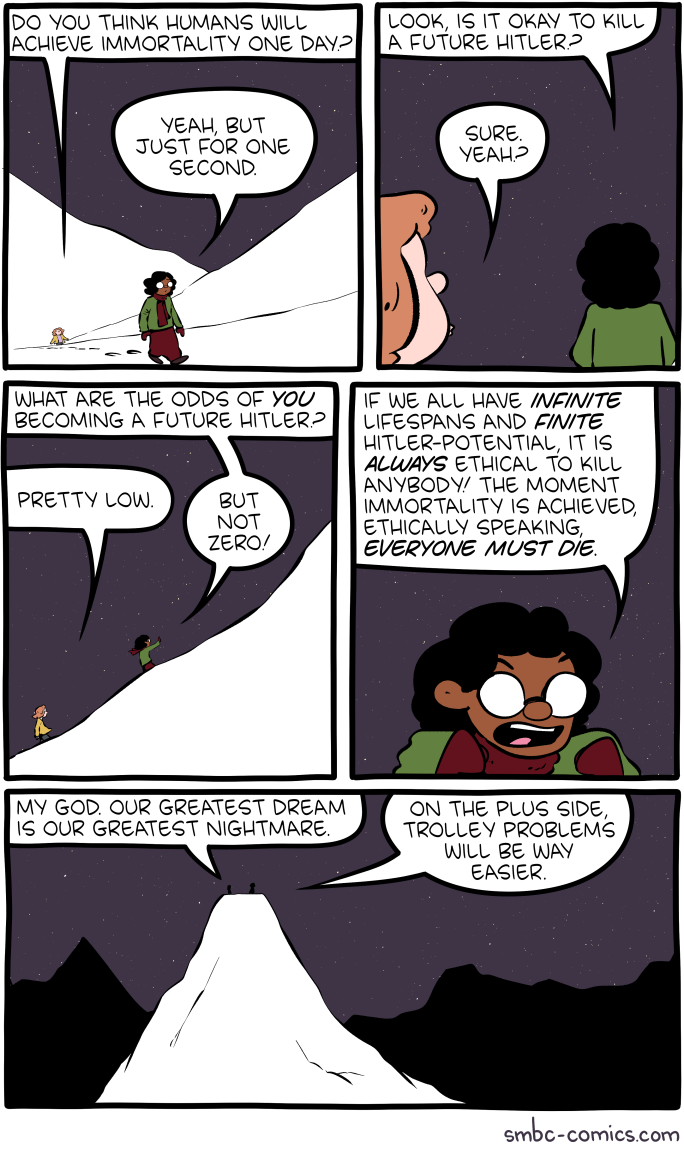
Click here to go see the bonus panel!
Hovertext:
When you add in the Stalin potential it gets really dicey.
Today's News:
Saturday Morning Breakfast Cereal: Saturday Morning Breakfast Cereal - Good News
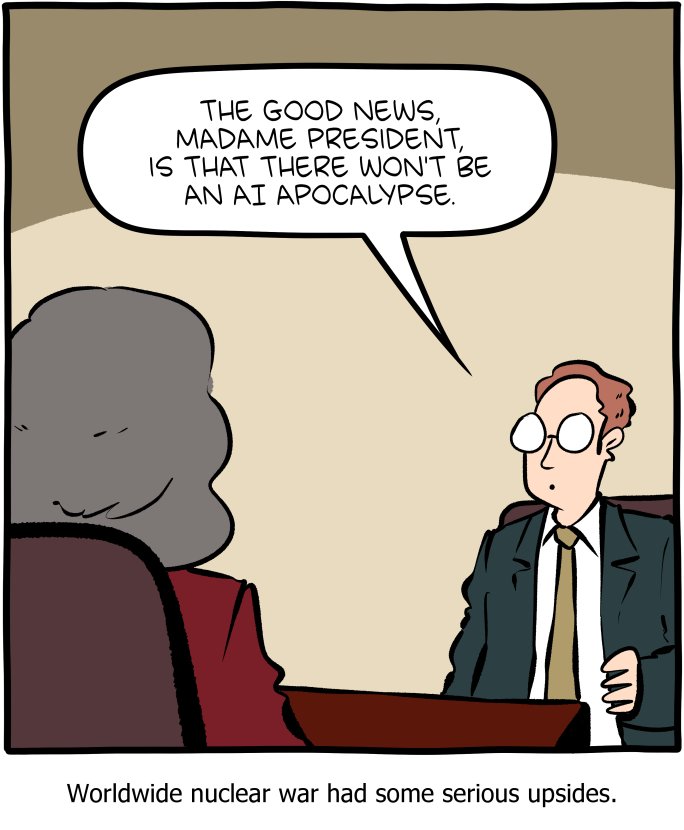
Click here to go see the bonus panel!
Hovertext:
The silver lining is due to cesium contamination.
Today's News:
new shelton wet/dry: ‘The old world is dying, and the new world struggles to be born: now is the time of monsters.’ –Antonio Gramsci
We do not have a veridical representation of our body in our mind. For instance, tactile distances of equal measure along the medial-lateral axis of our limbs are generally perceived as larger than those running along the proximal-distal axis. This anisotropy in tactile distances reflects distortions in body-shape representation, such that the body parts are perceived as wider than they are. While the origin of such anisotropy remains unknown, it has been suggested that visual experience could partially play a role in its manifestation.
To causally test the role of visual experience on body shape representation, we investigated tactile distance perception in sighted and early blind individuals […] Overestimation of distances in the medial-lateral over proximal-distal body axes were found in both sighted and blind people, but the magnitude of the anisotropy was significantly reduced in the forearms of blind people.
We conclude that tactile distance perception is mediated by similar mechanisms in both sighted and blind people, but that visual experience can modulate the tactile distance anisotropy.
new shelton wet/dry: from swerve of shore to bend of bay
Do you surf yourself?
No, I tried. I did it for about a week, 20 years ago. You have to dedicate yourself to these great things. And I don’t believe in being good at a lot of things—or even more than one. But I love to watch it. I think if I get a chance to be human again, I would do just that. You wake up in the morning and you paddle out. You make whatever little money you need to survive. That seems like the greatest life to me.
Or you could become very wealthy in early middle-age, stop doing the hard stuff, and go off and become a surfer.
No, no. You want to be broke. You want it to be all you’ve got. That’s when life is great. People are always trying to add more stuff to life. Reduce it to simpler, pure moments. That’s the golden way of living, I think.
related { Anecdote on Lowering the work ethic }
Greater Fool – Authored by Garth Turner – The Troubled Future of Real Estate: The 2-handle
To buy a house costing $2 million takes courage. And cash. Lots of it, including a 20% downpayment and a fat income. After putting $400,000 down and paying $73,000 in land transfer tax (in Toronto), the monthly mortgage nut is $10,300 (at 5.6%, five-year, 25-am). Plus property tax, insurance, utilities and upkeep. After shelling out $440,000 in interest over sixty months, you’d still owe $1.5 million.
By the way, this would require earnings of around $400,000 to qualify for financing. The average household income in T.O. is currently $110,000. Over 90% of people don’t make the cut.
So, how is this even possible? RBC already told us properties costing just over half this amount are severely unaffordable. The worst ever. Even when mortgages were 15% or more.
But wait. Look at what the house-humping Zoocasa site is claiming. The average house (not necessarily a nice one), it finds, will be at or above the $2 million mark by 2034. Ten years. So if you start today, kids, you only need to save $40,000 a year (and get a job as a bank CFO) to join in.
As rates fall, the Z people correctly point out, real estate rises in cost. “In the case that rates do begin declining this year, we can anticipate a corresponding price increase in the market overall, meaning we can reach this multimillion-dollar average home value even faster.”
Now, for the record, the sale price of a detached in 416 has touched $2 million briefly during a post-Covid Spring market. But it’s now retreated to the $1.7 million range. Of course, in many hoods $2 million continues to be merely the entry point. Rosedale is close to $4 million on average. Even the cheek-by-jowl mini McMansions of Leaside are routinely north of $2.5 million. The local real estate board stats show forty per cent of the entire city is in the two-mill zone. So, can prices actually migrate north everywhere?
Depends. If the economy stays positive and unemployment doesn’t spike (no recession) any interest rate declines will likely bring out more buyers willing to take the plunge. Meanwhile governments have been priming the pump. The latest dumb moves came from the feds, who have greenlit 30-year mortgages on new construction and bloated the RRSP homebuyer grab to $120,000 per couple.
Concurrently, Ottawa has seriously upped the capital gains inclusion rate on every investment asset save residential real estate. So, guess where more bucks will be flowing in the future? More dumbness.
Well, what’s the current thinking on rates?
Here are the expectations using the implied Canadian Dollar Offered Rate (CDOR) movements and probabilities based on BAX prices. In other words, what does Mr. Market think Tiff is gonna do?
The chances of a first cut of 25 basis points occurring in June sit at 74%. So, best plan on that happening. Further out, the betting is 50% that another quarter point will be shaved off in September, bringing the bank rate down to 4.5% and the bank prime to 6.7%.
By March of 2025 there’s currently an 86% chance the CB will slice another quarter point off, and a full-point drop (to 4%) will not occur until the autumn of next year (94% odds). So, clearly, rate expectations have been trimmed as the world steeps in volatility and, especially, as the US economy outperforms expectations.
This means the Fed will be higher for longer, while our CB lowers first to head off negative economic growth. As boss Jerome Powell said last week. “The recent data have clearly not given us greater confidence, and instead indicate that it’s likely to take longer than expected to achieve that confidence”. Just months ago the consensus of economists was for 125 bps of easing this year. That has now turned into just 40.
So, Mr. Market expects no change in June (83%), no change in July (57%), and maybe quarter-point drop in September (46%) and again in November (42%).
The American economy has surprised everyone, with 3% growth, full employment, rebounding profitability and over 20 new record stock market highs. Inflation is running hotter than in Canada and there’s consequently less pressure on the central bank. Complicating things is that weird presidential election – making Powell very cautious about any move that may be seen as political.
In short, it’s inevitable rates will drop. But not quite yet. Canada is also expected to see lower lending costs first. Combined with government desperation to encourage buyers, increase demand and push investment bucks from financials to real estate, the case for more house-buying remains strong.
And that sucks.
About the picture: “The “ferocious beast” picture in Thailand that you posted last week,” writes Alan, “prompted me to offer this picture taken outside a dog boutique (Feine pfote = Fine paws) in Linz, Austria while on our recent Rhine cruise (paid for out of our GT inspired b&d portfolio!) Thanks for the great daily reads.”
To be in touch or send a pisture of your beast, email to ‘garth@garth.ca’.
The Universe of Discourse: Talking Dog > Stochastic Parrot
I've recently needed to explain to nontechnical people, such as my chiropractor, why the recent ⸢AI⸣ hype is mostly hype and not actual intelligence. I think I've found the magic phrase that communicates the most understanding in the fewest words: talking dog.
These systems are like a talking dog. It's amazing that anyone could train a dog to talk, and even more amazing that it can talk so well. But you mustn't believe anything it says about chiropractics, because it's just a dog and it doesn't know anything about medicine, or anatomy, or anything else.
For example, the lawyers in Mata v. Avianca got in a lot of trouble when they took ChatGPT's legal analysis, including its citations to fictitious precendents, and submitted them to the court.
“Is Varghese a real case,” he typed, according to a copy of the exchange that he submitted to the judge.
“Yes,” the chatbot replied, offering a citation and adding that it “is a real case.”
Mr. Schwartz dug deeper.
“What is your source,” he wrote, according to the filing.
“I apologize for the confusion earlier,” ChatGPT responded, offering a legal citation.
“Are the other cases you provided fake,” Mr. Schwartz asked.
ChatGPT responded, “No, the other cases I provided are real and can be found in reputable legal databases.”
It might have saved this guy some suffering if someone had explained to him that he was talking to a dog.
The phrase “stochastic parrot” has been offered in the past. This is completely useless, not least because of the ostentatious word “stochastic”. I'm not averse to using obscure words, but as far as I can tell there's never any reason to prefer “stochastic” to “random”.
I do kinda wonder: is there a topic on which GPT can be trusted, a non-canine analog of butthole sniffing?
Addendum
I did not make up the talking dog idea myself; I got it from someone else. I don't remember who.
Planet Haskell: Mark Jason Dominus: Talking Dog > Stochastic Parrot
I've recently needed to explain to nontechnical people, such as my chiropractor, why the recent ⸢AI⸣ hype is mostly hype and not actual intelligence. I think I've found the magic phrase that communicates the most understanding in the fewest words: talking dog.
These systems are like a talking dog. It's amazing that anyone could train a dog to talk, and even more amazing that it can talk so well. But you mustn't believe anything it says about chiropractics, because it's just a dog and it doesn't know anything about medicine, or anatomy, or anything else.
For example, the lawyers in Mata v. Avianca got in a lot of trouble when they took ChatGPT's legal analysis, including its citations to fictitious precendents, and submitted them to the court.
“Is Varghese a real case,” he typed, according to a copy of the exchange that he submitted to the judge.
“Yes,” the chatbot replied, offering a citation and adding that it “is a real case.”
Mr. Schwartz dug deeper.
“What is your source,” he wrote, according to the filing.
“I apologize for the confusion earlier,” ChatGPT responded, offering a legal citation.
“Are the other cases you provided fake,” Mr. Schwartz asked.
ChatGPT responded, “No, the other cases I provided are real and can be found in reputable legal databases.”
It might have saved this guy some suffering if someone had explained to him that he was talking to a dog.
The phrase “stochastic parrot” has been offered in the past. This is completely useless, not least because of the ostentatious word “stochastic”. I'm not averse to using obscure words, but as far as I can tell there's never any reason to prefer “stochastic” to “random”.
I do kinda wonder: is there a topic on which GPT can be trusted, a non-canine analog of butthole sniffing?
Addendum
I did not make up the talking dog idea myself; I got it from someone else. I don't remember who.
Penny Arcade: Everything We Know about May/June Sticker Packs
I saw a Cybertruck in real life for the first time a few days ago. That is the ugliest vehicle I’ve ever seen and I can remember when people were buying the PT Cruiser. I can’t imagine a normal, human person seeing that monstrosity and thinking “That’s the truck for me!” What I’m saying is, Cybertruck owners don’t deserve rights.
Schneier on Security: Using Legitimate GitHub URLs for Malware
Interesting social-engineering attack vector:
McAfee released a report on a new LUA malware loader distributed through what appeared to be a legitimate Microsoft GitHub repository for the “C++ Library Manager for Windows, Linux, and MacOS,” known as vcpkg.
The attacker is exploiting a property of GitHub: comments to a particular repo can contain files, and those files will be associated with the project in the URL.
What this means is that someone can upload malware and “attach” it to a legitimate and trusted project.
As the file’s URL contains the name of the repository the comment was created in, and as almost every software company uses GitHub, this flaw can allow threat actors to develop extraordinarily crafty and trustworthy lures.
For example, a threat actor could upload a malware executable in NVIDIA’s driver installer repo that pretends to be a new driver fixing issues in a popular game. Or a threat actor could upload a file in a comment to the Google Chromium source code and pretend it’s a new test version of the web browser.
These URLs would also appear to belong to the company’s repositories, making them far more trustworthy.
ScreenAnarchy: Sound And Vision: Luca Guadagnino
 In the article series Sound and Vision we take a look at music videos from notable directors. This week we take a look at several music videos by Luca Guadagnino. Luca Guadagnino's films are vibrant and lush, pulsating with life and a heartbeat, like music. He is often one to curate his soundtracks carefully, with the likes of The Rolling Stones, Harry Nilsson, Captain Beefheart, Sufjan Stevens, Trent Reznor and Atticus Ross, Thom Yorke and John Adams showing up on his soundtracks. Sometimes he chooses pre-existing tracks, but more often he asks his favorite artists to provide the sonic backdrop for his films. It is fitting that a few of the music videos Guadagnino directed are for tracks tailor made for his own features, starting...
In the article series Sound and Vision we take a look at music videos from notable directors. This week we take a look at several music videos by Luca Guadagnino. Luca Guadagnino's films are vibrant and lush, pulsating with life and a heartbeat, like music. He is often one to curate his soundtracks carefully, with the likes of The Rolling Stones, Harry Nilsson, Captain Beefheart, Sufjan Stevens, Trent Reznor and Atticus Ross, Thom Yorke and John Adams showing up on his soundtracks. Sometimes he chooses pre-existing tracks, but more often he asks his favorite artists to provide the sonic backdrop for his films. It is fitting that a few of the music videos Guadagnino directed are for tracks tailor made for his own features, starting...
Colossal: Ewa Juszkiewicz’s Reimagined Historical Portraits of Women Scrutinize the Nature of Concealment

“Untitled (after Élisabeth Vigée Le Brun)” (2020), oil on canvas, 130 x 100 centimeters. All images © the artist, courtesy of Almine Rech, shared with permission
From elaborate hairstyles to hypertrophied mushrooms, an array of unexpected face coverings feature in Ewa Juszkiewicz’s portraits. Drawing on genteel likenesses of women primarily from the 18th and 19th centuries, the artist superimposes fabric, bouquets of fruit, foliage, and more, over the women’s faces.
In a collateral event during the 60th Annual Venice Biennale, presented by the Fundación Almine y Bernard Ruiz-Picasso and Almine Rech, Juszkiewicz presents a suite of works made between 2019 and 2024 that encapsulate her precise reconception of a popular Western genre. Locks with Leaves and Swelling Buds showcases her elaborate, technically accomplished pieces using traditional oil painting and varnishing techniques.
Juszkiewicz’s anonymous subjects are reminders of the systemic omission of women from the histories of art and the past more broadly. Literally in the face of portraits meant to memorialize and celebrate individuals, the artist erases their identities entirely, alluding only to the original artists’ names in the titles. In a seemingly contradictory approach, by drawing our attention to this erasure, Juszkiewicz stokes our curiosity about who they were.
“By covering the face of historical portraits, Juszkiewicz challenges the very essence of this genre: she destroys the portrait as such,” says curator Guillermo Solana. In a recent video, we get a peek inside the artist’s studio, where she describes how elements of another European painting tradition, the still life, proffers a rich well of symbolic objects to conceal each sitter’s face, from botanicals to ribbons to food.
Locks with Leaves and Swilling Buds continues in Venice at Palazzo Cavanis through September 1. Find more on the artist’s website and Instagram.

“Untitled (after François Gérard)” (2023), oil on canvas, 100 x 80 centimeters

“Untitled (after Joseph van Lerius)” (2020), oil on canvas, 70 x 55 centimeters

Left: “Portrait in Venetian Red (after Élisabeth-Louise Vigée Le Brun)” (2024), oil on canvas, 190 x 140 centimeters. Right: “Lady with a Pearl (after François Gérard)” (2024), oil on canvas, 80 x 65 centimeters

“Bird of paradise” (2023) oil on canvas, 200 x 160 centimeters. Photo by Serge Hasenböhler Fotografie
Do stories and artists like this matter to you? Become a Colossal Member today and support independent arts publishing for as little as $5 per month. The article Ewa Juszkiewicz’s Reimagined Historical Portraits of Women Scrutinize the Nature of Concealment appeared first on Colossal.
CreativeApplications.Net: Toaster-Typewriter – An investigation of humor in design

Toaster-Typewriter is the first iteration of what technology made with humor can do. A custom made machine that lets one burn letters onto bread, this hybrid appliance nudges users to exercise their imaginations while performing a mundane task like making toast in the morning.
Category: Objects
Tags: absurd / critique / device / eating / education / emotion / engineering / experience / experimental / machine / Objects / parsons / playful / politics / process / product design / reverse engineering / storytelling / student / technology / typewriter
People: Ritika Kedia
Michael Geist: The Law Bytes Podcast, Episode 200: Colin Bennett on the EU’s Surprising Adequacy Finding on Canadian Privacy Law

A little over five years ago, I launched the Law Bytes podcast with an episode featuring Elizabeth Denham, then the UK’s Information and Privacy Commissioner, who provided her perspective on Canadian privacy law. I must admit that I didn’t know what the future would hold for the podcast, but I certainly did not envision reaching 200 episodes. I think it’s been a fun, entertaining, and educational ride. I’m grateful to the incredible array of guests, to Gerardo Lebron Laboy, who has been there to help produce every episode, and to the listeners who regularly provide great feedback.
The podcast this week goes back to where it started with a look at Canadian privacy through the eyes of Europe. It flew under the radar screen for many, but earlier this year the EU concluded that Canada’s privacy law still provides an adequate level of protection for personal information. The decision comes as a bit of surprise to many given that Bill C-27 is currently at clause-by-clause review and there has been years of criticism that the law is outdated. To help understand the importance of the EU adequacy finding and its application to Canada, Colin Bennett, one of the world’s leading authorities on privacy and privacy governance, joins the podcast.
The podcast can be downloaded here, accessed on YouTube, and is embedded below. Subscribe to the podcast via Apple Podcast, Google Play, Spotify or the RSS feed. Updates on the podcast on Twitter at @Lawbytespod.
Show Notes:
Bennett, The “Adequacy” Test: Canada’s Privacy Protection Regime Passes, but the Exam Is Still On
EU Adequacy Finding, January 2024
Credits:
EU Reporter, EU Grants UK Data Adequacy for a Four Year Period
The post The Law Bytes Podcast, Episode 200: Colin Bennett on the EU’s Surprising Adequacy Finding on Canadian Privacy Law appeared first on Michael Geist.
Ideas: Salmon depletion in Yukon River puts First Nations community at risk
Once, there were half a million salmon in the Yukon River, but now they're almost gone. For the Little Salmon Carmacks River Nation, these salmon are an essential part of their culture — and now their livelihood is in peril. IDEAS shares their story as they struggle to keep their identity after the loss of the salmon migration.
Colossal: Diverse Expressions: 5 Artwork Themes to Discover at The Other Art Fair Brooklyn This May

Dawn Beckles, “Forever The Cream” (2023), acrylic, charcoal, gold leaf, spray paint, paper on canvas
Get ready for an art event unlike any other. The Other Art Fair presented by Saatchi Art returns to ZeroSpace in Brooklyn from May 16 to 19. With each new fair comes new experiences, and this edition is no different as it unveils a vibrant roster of fresh artwork, new talents, and unexpected delights.
This May installment promises an array of exciting features, including 120+ independent artists set to showcase their collections, the 10th edition of Mike Perry and Josh Cochran’s “Get Nude, Get Drawn” portrait experience, complimentary hand-crafted whisky cocktails (exclusively for those aged 21+) on Thursday’s Opening Night, and live performances on both Opening Night and the highly anticipated Friday Late soirée.
Ahead of the main event, we’re highlighting five categories of artists based on shared themes, offering a look at the diverse range of artistic practices at this year’s fair.
Still life
Bella Wattles fuses colorful objects, ceramics, and thrifted treasures into whimsical paintings that echo societal harmony and celebrate women and LGBTQ+ creators.
Still lifes by self-taught artist Dawn Beckles bridge the energies of London and the Caribbean. Her bold strokes celebrate the beauty of everyday moments, inviting viewers to reconnect with their own stories.

Bryane Broadie, “Mind Growth”
Celebrating Black Portraiture
Bryane Broadie, a graphic artist from Prince George’s County, Maryland, discovered his passion for art in elementary school. His digital and mixed media works reflect Black history and culture.
Inspired by childhood resourcefulness and Brooklyn’s cultural tapestry, Sean Qualls crafts evocative illustrations and paintings. His work investigates identity, history, the human spirit, and universal human experiences.

Carrie Lipscomb, “Blocks (small)” (2024), thread on fine art paper
Embossed and Embroidered
Guided by pure geometries, Brooklyn-based mixed-media artist Carrie Lipscomb explores space and texture, urging viewers to engage with the subtleties in found materials.
Sophie Reid is a visual storyteller who blends geometric shapes across multimedia. She honed her craft as a graphic designer and in her art, she uses illustrations and stitch works to echo her love for design and travel.

Isabella Bejarano, “Silver Water” (2015), fine art photography print in a custom aqua plexi shadowbox frame, limited edition of 25
New Mediums
Mounts in colored acrylic boxes: NYC-based Venezuelan-born photographer Isabella Bejarano champions environmental causes through her sustainable fine art prints, donating proceeds to combat climate change.
Film lightboxes: Montreal-based artist and film aficionado Hugo Cantin creates patterned collages on vintage film stock. Housed in light boxes, his illuminated creations fuse sophisticated design with historical narratives.

Patrick Skals, “THE WRITING IS ON THE WALL” (2023), acrylic, ink, and watercolor on canvas
Text
Toronto artist Patrick Skals escaped the corporate world in 2019 to pursue his unique vision. His collection, In Other Words, aims to disrupt norms with abstract commentary, challenging viewers to be introspective.
Kelli Kikcio, an artist from Toronto now based in Brooklyn, takes a hands-on approach in her work, which reflects her commitment to social justice and community engagement.
See work by all these artists and more at The Other Art Fair’s Brooklyn edition, on view from May 16 to 19.
Grab your tickets for an unforgettable weekend at theotherartfair.com.
Do stories and artists like this matter to you? Become a Colossal Member today and support independent arts publishing for as little as $5 per month. The article Diverse Expressions: 5 Artwork Themes to Discover at The Other Art Fair Brooklyn This May appeared first on Colossal.
Open Culture: Humans First Started Enjoying Cannabis in China Circa 2800 BC
Judging by how certain American cities smell these days, you’d think cannabis was invented last week. But that spike in enthusiasm, as well as in public indulgence, comes as only a recent chapter in that substance’s very long history. In fact, says the presenter of the PBS Eons video above, humanity began cultivating it “in what’s now China around 12,000 years ago. This makes cannabis one of the single oldest known plants we domesticate,” even earlier than “staples like wheat, corn, and potatoes.” By that time scale, it wasn’t so long ago — four millennia or so — that the lineages used for hemp and for drugs genetically separated from each other.
The oldest evidence of cannabis smoking as we know it, also explored in the Science magazine video below, dates back 2,500 years. “The first known smokers were possibly Zoroastrian mourners along the ancient Silk Road who burned pot during funeral rituals,” a proposition supported by the analysis of the remains of ancient braziers found at the Jirzankal cemetery, at the foot of the Pamir mountains in western China. “Tests revealed chemical compounds from cannabis, including the non-psychoactive cannabidiol, also known as CBD” — itself reinvented in our time as a thoroughly modern product — and traces of a THC byproduct called cannabinol “more intense than in other ancient samples.”
What made the Jirzankal cemetery’s stash pack such a punch? “The region’s high altitude could have stressed the cannabis, creating plants naturally high in THC,” writes Science’s Andrew Lawler. “But humans may also have intervened to breed a more wicked weed.” As cannabis-users of the sixties and seventies who return to the fold today find out, the weed has grown wicked indeed over the past few decades. But even millennia ago and half a world away, civilizations that had incorporated it for ritualistic use — or as a medical treatment — may already have been agriculturally guiding it toward greater potency. Your neighborhood dispensary may not be the most sublime place on Earth, but at least, when next you pay it a visit, you’ll have a sound historical reason to cast your mind to the Central Asian steppe.
Related content:
The Drugs Used by the Ancient Greeks and Romans
Algerian Cave Paintings Suggest Humans Did Magic Mushrooms 9,000 Years Ago
Pipes with Cannabis Traces Found in Shakespeare’s Garden, Suggesting the Bard Enjoyed a “Noted Weed”
Reefer Madness, 1936’s Most Unintentionally Hilarious “Anti-Drug” Exploitation Film, Free Online
Carl Sagan on the Virtues of Marijuana (1969)
Watch High Maintenance: A Critically-Acclaimed Web Series About Life & Cannabis
The New Normal: Spike Jonze Creates a Very Short Film About America’s Complex History with Cannabis
Based in Seoul, Colin Marshall writes and broadcasts on cities, language, and culture. His projects include the Substack newsletter Books on Cities, the book The Stateless City: a Walk through 21st-Century Los Angeles and the video series The City in Cinema. Follow him on Twitter at @colinmarshall or on Facebook.
Penny Arcade: Cyberyuck
TOPLAP: It’s a big week for live coding in France!
Last week it was /* VIU */ in Barcelona, this week it’s France!
Events
- Live Coding Study Day April 23, 2024
Organizers: Raphaël Forment, Agathe Herrou, Rémi Georges- 2 Academic sessions
- Speakers: Julian Rohrhuber, Yann Orlarey, and Stéphane Letz
- Evening concert, featuring performances selected by Artistic Director Rémi Georges balancing originality with a mix of local French and international artists. Lineup: Jia Liu (GER), Bruno Gola (Brazil/Berlin), Adel Faure (FR), ALFALFL (FR), Flopine (FR).
“While international networks centered on live-coding have been established for nearly 20 years through the TOPLAP collective, no academic event has ever taken place in France on this theme. The goal of this study day is to put in motion a national research network connected to its broader european and international counterparts.”
- Algorave in Lyon April 27 – 28 (12 hrs!) Live Streamed to YouTube.com/eulerroom
The 12 hour marathon Algorave is emerging as a unique French specialty (or maybe they just enjoy self-inflicted exhaustion…) Last year was a huge success so the team is back at it for more! 24 sound and/or visual artists including: th4, zOrg, Raphaël Bastide, Crash Server, Eloi el bon Noi, Adel Faure, Fronssons, QBRNTHSS, Bubobubobubo, azertype, eddy flux, + many more.
Rave on!
Disquiet: Pre-Show (Bill Frisell & Co.)
As I type this, I’m preparing to drive over to Berkeley, from San Francisco, to see guitarist Bill Frisell in a sextet that will be premiering new music. The group, who will play at Freight & Salvage, consists of Frisell plus violinist Jenny Scheinman, violist Eyvind Kang, cellist Hank Roberts, bassist Thomas Morgan, and drummer Rudy Royston.
There is, as far as I can tell, no available footage or audio of them playing as a group, so I’ve been piecing together a mental sonic image, as it were, from various smaller group settings.
These two short videos are all the strings from the sextet excepting the bass, filmed back on November 4, 2017. It’s the same group (Frisell, Sheinman, Kang, Roberts) who recorded the 2011 album Sign of Life (Savoy) and the 2005 album Richter 858 (Songlines). The latter was recorded back in 2002, so this is no new partnership by any means.
Roberts has, I believe, with Frisell, the longest-running association of all the musicians playing in the premiere. There’s plenty of examples, both commercial releases and live video, including this short piece, recorded June 15, 2014, at the New Directions Cello Festival, at Ithaca College, in Ithaca, New York.
Roberts was one of the first musicians I interviewed professionally, shortly after I got out of college in 1988. By then I had interviewed numerous musicians for a school publication, including the drummer Bill Bruford (Yes, King Crimson) and the Joseph Shabalala (founder of the vocal group Ladysmith Black Mambazo). After school I moved to New York City (first Manhattan and then Brooklyn), and for a solid swath of that time I was lucky to score a shared apartment on Crosby Street just south of Houston, incredibly close to the Knitting Factory, where I went several times a week and saw Frisell, Roberts, and so many “Downtown” musicians of that era in each other’s groups. I also saw Frisell play at the Village Vanguard around that time, but mostly just went to whatever was at the Knitting Factory on a given night. When I interviewed Roberts, it was on the subject of his then fairly new record, Black Pastels. (I wrote the piece for Pulse! magazine, published by Tower Records. In 1989 I moved to California to be an editor at Pulse!)
Frisell, bassist Morgan, and drummer Royston have recorded and toured widely and frequently in recent years. Here they are on July 3, 2023, at Arts Center at Duck Creek.
I’m imagining tonight’s music will have the “chamber Americana” quality of the quartet heard above, but the presence of Royston may rev things up a little, and it may have more of a jazz quality, closer to the trio work highlighted here.
The Shape of Code: Relative sizes of computer companies
How large are computer companies, compared to each other and to companies in other business areas?
Stock market valuation is a one measure of company size, another is a company’s total revenue (i.e., total amount of money brought in by a company’s operations). A company can have a huge revenue, but a low stock market valuation because it makes little profit (because it has to spend an almost equally huge amount to produce that income) and things are not expected to change.
The plot below shows the stock market valuation of IBM/Microsoft/Apple, over time, as a percentage of the valuation of tech companies on the US stock exchange (code+data on Github):

The growth of major tech companies, from the mid-1980s caused IBM’s dominant position to dramatically decline, while first Microsoft, and then Apple, grew to have more dominant market positions.
Is IBM’s decline in market valuation mirrored by a decline in its revenue?
The Fortune 500 was an annual list of the top 500 largest US companies, by total revenue (it’s now a global company list), and the lists from 1955 to 2012 are available via the Wayback Machine. Which of the 1,959 companies appearing in the top 500 lists should be classified as computer companies? Lacking a list of business classification codes for US companies, I asked Chat GPT-4 to classify these companies (responses, which include a summary of the business area). GPT-4 sometimes classified companies that were/are heavy users of computers, or suppliers of electronic components as a computer company. For instance, I consider Verizon Communications to be a communication company.
The plot below shows the ranking of those computer companies appearing within the top 100 of the Fortune 500, after removing companies not primarily in the computer business (code+data):

IBM is the uppermost blue line, ranking in the top-10 since the late-1960s. Microsoft and Apple are slowly working their way up from much lower ranks.
These contrasting plots illustrate the fact that while IBM continued to a large company by revenue, its low profitability (and major losses) and the perceived lack of a viable route to sustainable profitability resulted in it having a lower stock market valuation than computer companies with much lower revenues.
new shelton wet/dry: shadow trading
No evidence for differences in romantic love between young adult students and non-students — The findings suggest that studies investigating romantic love using student samples should not be considered ungeneralizable simply because of the fact that students constitute the sample.
Do insects have an inner life? Crows, chimps and elephants: these and many other birds and mammals behave in ways that suggest they might be conscious. And the list does not end with vertebrates. Researchers are expanding their investigations of consciousness to a wider range of animals, including octopuses and even bees and flies. […] Investigations of fruit flies (Drosophila melanogaster) show that they engage in both deep sleep and ‘active sleep’, in which their brain activity is the same as when they’re awake. “This is perhaps similar to what we call rapid eye movement sleep in humans, which is when we have our most vivid dreams, which we interpret as conscious experiences”
“This research shows the complexity of how caloric restriction affects telomere loss” After one year of caloric restriction, the participant’s actually lost their telomeres more rapidly than those on a standard diet. However, after two years, once the participants’ weight had stabilized, they began to lose their telomeres more slowly.
”It would mean that two-thirds of the universe has just disappeared”
AI study shows Raphael painting was not entirely the Master’s work
I bought 300 emoji domain names from Kazakhstan and built an email service [2021]
Shadow trading is a new type of insider trading that affects people who deal with material nonpublic information (MNPI). Insider trading involves investment decisions based on some kind of MNPI about your own company; shadow trading entails making trading decisions about other companies based on your knowledge of external MNPI. The issue has yet to be fully resolved in court, but the SEC is prosecuting this behavior. More: we provide evidence that shadow trading is an undocumented and widespread mechanism that insiders use to avoid regulatory scrutiny
The sessile lifestyle of acorn barnacles makes sexual reproduction difficult, as they cannot leave their shells to mate. To facilitate genetic transfer between isolated individuals, barnacles have extraordinarily long penises. Barnacles probably have the largest penis-to-body size ratio of the animal kingdom, up to eight times their body length
Daniel Lemire's blog: How do you recognize an expert?
Go back to the roots: experience. An expert is someone who has repeatedly solved the concrete problem you are encountering. If your toilet leaks, an experienced plumber is an expert. An expert has a track record and has had to face the consequences of their work. Failing is part of what makes an expert: any expert should have stories about how things went wrong.
I associate the word expert with ‘the problem’ because we know that expertise does not transfer well: a plumber does not necessarily make a good electrician. And within plumbing, there are problems that only some plumbers should solve. Furthermore, you cannot abstract a problem: you can study fluid mechanics all you want, but it won’t turn you into an expert plumber.
That’s one reason why employers ask for relevant experience: they seek expertise they can rely on. It is sometimes difficult to acquire expertise in an academic or bureaucratic setting because the problems are distant or abstract. Your experience may not translate well into practice. Sadly we live in a society where we often lose track of and undervalue genuine expertise… thus you may take software programming classes from people who never built software or civil engineering classes from people who never worked on infrastructure projects.
So… how do you become an expert? Work on real problems. Do not fall for reverse causation: if all experts dress in white, dressing in white won’t turn you into an expert. Listening to the expert is not going to turn you into an expert. Lectures and videos can be inspiring but they don’t build your expertise. Getting a job with a company that has real problems, or running your own business… that’s how you acquire experience and expertise.
Why would you want to when you can make a good living otherwise, without the hard work of solving real problems? Actual expertise is capital that can survive a market crash or a political crisis. After Germany’s defeat in 1945… many of the aerospace experts went to work for the American government. Relevant expertise is robust capital.
Why won’t everyone seek genuine expertise? Because there is a strong countervailing force: showing a total lack of practical skill is a status signal. Wearing a tie shows that you don’t need to work with your hands.
But again: don’t fall for reverse causality… broadcasting that you don’t have useful skills might be fun if you are already of high status… but if not, it may not grant you a higher status.
And status games without a solid foundation might lead to anxiety. If you can get stuff done, if you can fix problems, you don’t need to worry so much about what people say about you. You may not like the color of the shoes of your plumber, but you won’t snob him over it.
So get expertise and maintain it. You are likely to become more confident and happier.
Colossal: Street Photographer Tony Van Le Captures Beauty in Brevity

“The Magic Number.” All images © Tony Van Le, shared with permission
As John Koening writes in The Dictionary of Obscure Sorrows, the term sonder refers to “the realization that each random passerby is living a life as vivid and complex as your own—an epic story that continues invisibly around you.” This profound feeling reveals itself in Tony Van Le’s street photography, circling around the meaningful coincidences that he captures instantaneously.
Le is fueled by serendipity and strangeness. Having originally explored these grounds through music production, the artist has since moved toward manifesting a similar ethos through photography. Impassioned by the transient work of Vivian Maier, Le has spent years cultivating this calling, becoming more confident with focusing his lens on strangers over time. Purely candid and wondrously ephemeral, the artist approaches each street scene with a clear mind.
He explains, “When I’m out on the street, my mindset combines looking for the out-of-the-ordinary with trying to be a blank slate. By being fully attuned to the moment, I’m more open to the photographic potential of what I encounter.” Although fleeting, each snapshot is a reminder of the wonder that comes from being fully present and deeply sensitive toward life’s mundane charm.
Le has a number of ongoing projects, which you can find on his website. He will also be exhibiting at Gallery-O-Rama in July, so follow along on Instagram for updates.

“Into the Unknown”

“Man and Iguana”

“Metacognition”

“Woman with Mannequin on Motorbike”

“Diverse Pathways”

“Bicyclist and Steam”

“Among Us”

“Police Officer, Red-Tailed Hawk, and Rodent”

“Nature’s Crown”
Do stories and artists like this matter to you? Become a Colossal Member today and support independent arts publishing for as little as $5 per month. The article Street Photographer Tony Van Le Captures Beauty in Brevity appeared first on Colossal.
Saturday Morning Breakfast Cereal: Saturday Morning Breakfast Cereal - The Test
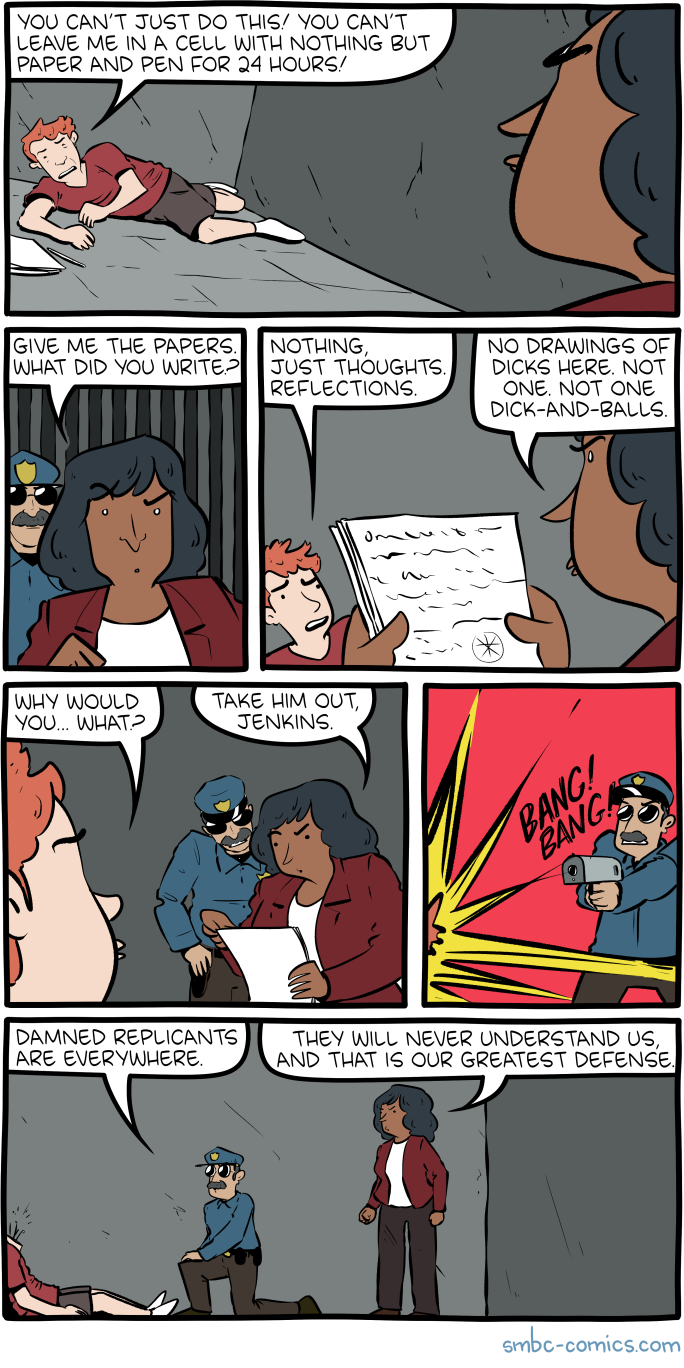
Click here to go see the bonus panel!
Hovertext:
Look it's the only test with no false negatives.
Today's News:
Trivium: 21apr2024
Building a GPS Receiver using RTL-SDR, by Phillip Tennen.
Reproducing EGA typesetting with LaTeX, using the Baskervaldx font.
The Solution of the Zodiac Killer’s 340-Character Cipher, final, comprehensive report on the project by David Oranchak, Sam Blake, and Jarl Van Eycke.
Bridging brains: exploring neurosexism and gendered stereotypes in a mindsport, by Samantha Punch, Miriam Snellgrove, Elizabeth Graham, Charlotte McPherson, and Jessica Cleary.
Yotta is a minimalistic forth-like language bootstrapped from x86_64 machine code.
SSSL - Hackless SSL bypass for the Wii U, released one day after shutdown of the official Nintendo servers.
stagex, a container-native, full-source bootstrapped, and reproducible toolchain.
Computing Adler32 Checksums at 41 GB/s, by wooosh.
Random musings on the Agile Manifesto
doom-htop, “Ever wondered whether htop could be used to render the graphics of cult video games?”
A proper cup of tea, try this game!
Greater Fool – Authored by Garth Turner – The Troubled Future of Real Estate: The Sharia scare
“I’m Muslim,” Sam said. “So I can’t.”
We were building him a retirement portfolio a few years ago. Sam told me all about riba. Also why he couldn’t own any bonds, have a regular savings account or be talked into a GIC by TNL@TB.
He explained that Muslims who adhere to Islamic law have a different relationship with money. It’s not an asset all on its own, he told me. Instead money’s just a way of measuring things – like the value of work or the cost of a bungalow in Brantford. When you look at currency like that, it’s unethical (and wrong) to receive interest income from money alone. It’s called riba, and Islamic law forbids it.
So this is why Sam couldn’t own a bond paying interest semi-annually, or a GIC that dumped an earned amount into his lap each year. Or even a bank savings account earning a piddling little amount. He had one of those, he told me, but because riba cannot be used for personal benefit, he donated those dollars to the mosque.
We solved the portfolio thing easily. Bond ETFs don’t pay interest, but dividends which represent the earned amount and any capital gain. For tax purposes these are treated either as income or gains, and therefore comply with religious tenets.
But here was Sam’s real problem: getting a mortgage.
Home loans come with a big interest component – in fact, in the early years of amortization it’s the largest component of monthly payments. For a few years Muslim-friendly mortgages have been available from a few lenders, but they’ve been scarce and expensive, owing partly to the fact Muslims don’t believe in foreclosures, either. So the cost of a ‘halal’ loan (that means ’permitted’) has been about 4% more than non-believers pay for bank mortgages.
That brings us to Tuesday last. Ottawa’s federal budget is, “exploring new measures to expand access to halal mortgages” and other non-traditional borrowings.
Well, guess what happened next?
“Trudeau bringing Sharia law to Canada!” screamed the first of a slew of comments posted to this blog (all deleted). Soon social media was more of a dank, poisonous swamp than usual. The extreme elements of historical Sharia law (lashings, stonings, amputation for relatively minor crimes plus the subjugation of women) were bandied about as if soon to come to your hood. And people wondered why, if Muslims can get mortgages without interest being charged, the rest of us can’t?
As usual, there were two things in the background. Ignorance. And political manipulation.
I’m no expert on religious laws, the Quran or Islam, but the idea behind halal mortgages seems pretty simple. The buyer still pays the lender, just in a different way and just as much (or more). In one form, the lender buys the property with the purchaser in a rent-to-own situation. Or buyer and lender enter into a partnership with ownership being transferred as lump sum payments are made. In any case, there’s a profit component built in for the finance company that equals what a traditional amortized mortgage would yield. Presumably the feds are looking to allow more lenders to get into the game by figuring out appropriate forms of CMHC insurance, now that Muslim families form a growing (5% or 1.7 million) hunk of the population.
So, a halal mortgage ain’t cheaper. Nobody gets a free pony.
But what we all get is a new way for the haters to express prejudice. Just as the MAGA adherents to the south have vilified immigrants (especially the brown ones) and as ‘Christian nationalism’ is embraced by Donald Trump, society grows darker. Sadly, the rightist and populist movements there, here and in Europe attract followers by seeking to turn the clock back, recalling a former, whiter, more comfortable and familiar world. And so the man who may become the most powerful person in the world can call newcomers to his country ‘vermin’ and ‘animals’, suggesting they are ‘poisoning’ America and its school system.
Never in a lifetime did we think this could happen. But here we are.
For the record, Muslim-friendly home loans are a nothingburger. They don’t give borrowers an advantage. They level the playing field. They do not mean Sharia law is being imposed, enacted or considered. You are not being threatened.
Also for the record, how can thinking about money this way be a bad thing? Value what it does, not what it is.
About the picture: “Your favourite millennial here,” writes Liam. “My wife and I just adopted Lenny here from a breeder on Vancouver Island. He’s adjusting to life in Montreal well, but, like his main man, struggles with the language, the sporadic street cleaning and joykill landlords.”
To be in touch or send a picture of your beast, email to ‘garth@garth.ca’.
Planet Haskell: Oleg Grenrus: A note about coercions
Safe coercions in GHC are a very powerful feature. However, they are not perfect; and already many years ago I was also thinking about how we could make them more expressive.
In particular such things like "higher-order roles" have been buzzing. For the record, I don't think Proposal #233 is great; but because that proposal is almost four years old, I don't remember why; nor I have tangible counter-proposal either.
So I try to recover my thoughts.
I like to build small prototypes; and I wanted to build a small language with zero-cost coercions.
The first approach, I present here, doesn't work.
While it allows model coercions, and very powerful ones, these coercions are not zero-cost as we will see. For language like GHC Haskell where being zero-cost is non-negotiable requirement, this simple approach doesn't work.
The small "formalisation" is in Agda file https://gist.github.com/phadej/5cf29d6120cd27eb3330bc1eb8a5cfcc
Syntax
We start by defining syntax. Our language is "simple": there are types
A, B = A -> B -- function type, "arrow"coercions
co = refl A -- reflexive coercion
| sym co -- symmetric coercions
| arr co₁ co₂ -- coercion of arrows built from codomain and domain
-- type coercionsand terms
f, t, s = x -- variable
| f t -- application
| λ x . t -- lambda abstraction
| t ▹ co -- castObviously we'd add more stuff (in particular, I'm interested in expanding coercion syntax), but these are enough to illustrate the problem.
Because the language is simple (i.e. not dependent), we can define typing rules and small step semantics independently.
Typing
There is nothing particularly surprising in typing rules.
We'll need a "well-typed coercion" rules too though, but these are also very straigh-forward
Coercion Typing: Δ ⊢ co : A ≡ B
------------------
Δ ⊢ refl A : A ≡ A
Δ ⊢ co : A ≡ B
------------------
Δ ⊢ sym co : B ≡ A
Δ ⊢ co₁ : C ≡ A
Δ ⊢ co₂ : D ≡ B
-------------------------------------
Δ ⊢ arr co₁ co₂ : (C -> D) ≡ (A -> B)Terms typing rules are using two contexts, for term and coercion variables (GHC has them in one, but that is unhygienic, there's a GHC issue about that). The rules for variables, applications and lambda abstractions are as usual, the only new is the typing of the cast:
Term Typing: Γ; Δ ⊢ t : A
Γ; Δ ⊢ t : A
Δ ⊢ co : A ≡ B
-------------------------
Γ; Δ ⊢ t ▹ co : B So far everything is good.
But when playing with coercions, it's important to specify the reduction rules too. Ultimately it would be great to show that we could erase coercions either before or after reduction, and in either way we'll get the same result. So let's try to specify some reduction rules.
Reduction rules
Probably the simplest approach to reduction rules is to try to inherit most reduction rules from the system without coercions; and consider coercions and casts as another "type" and "elimination form".
An elimination of refl would compute trivially:
t ▹ refl A ~~> tThis is good.
But what to do when cast's coercion is headed by arr?
t ▹ arr co₁ co₂ ~~> ???One "easy" solution is to eta-expand t, and split the coercion:
t ▹ arr co₁ co₂ ~~> λ x . t (x ▹ sym co₁) ▹ co₂We cast an argument before applying it to the function, and then cast the result. This way the reduction is type preserving.
But this approach is not zero-cost.
We could not erase coercions completely, we'll still need some indicator that there were an arrow coercion, so we'll remember to eta-expand:
t ▹ ??? ~~> λ x . t xConclusion
Treating coercions as another type constructor with cast operation being its elimination form may be a good first idea, but is not good enough. We won't be able to completely erase such coercions.
Another idea is to complicate the system a bit. We could "delay" coercion elimination until the result is scrutinised by another elimination form, e.g. in application case:
(t ▹ arr co₁ co₂) s ~~> t (s ▹ sym co₁) ▹ co₂ And that is the approach taken in Safe Zero-cost Coercions for Haskell, you'll need to look into JFP version of the paper, as that one has appendices.
(We do not have space to elaborate, but a key example is the use ofnthin ruleS_KPUSH, presented in the extended version of this paper.)
The rule S_Push looks some what like:
---------------------------------------------- S_Push
(t ▹ co) s ~~> t (s ▹ sym (nth₁ co)) ▹ nth₂ cowhere we additionally have nth coercion constructor to decompose coercions.
Incidentally there was, technically is, a proposal to remove decomposition rule, but it's a wrong solution to the known problem. The problem and a proper solution was kind of already identified in the original paper
We could similarly imagine a lattice keyed by classes whose instance definitions are to be respected; with such a lattice, we could allow the coercion ofMap Int vtoMap Age vprecisely whenInt’s andAge’sOrdinstances correspond.
The original paper also identified the need for higher-order roles. And also identified that
This means that Monad instances could be defined only for types
that expect a representational parameter.
which I argue should be already required for Functor (and traverseBia hack with unlawful Mag would still work if GHC had unboxed representational coercions, i.e. GADTs with baked-in representational (not only nominal) coercions).
There also the mention of unidirectional Coercible, which people asked about later and recently:
Such uni-directional version of Coercible amounts to explicit
inclusive subtyping and is more complicated than our current symmetric system.
It is fascinating that authors were able to predict the relevant future work so well. And I'm thankful that GHC got Coercible implemented even it was already known to not be perfect. It's useful nevertheless. But I'm sad that there haven't been any results of future work since.
Embedded in Academia: Dataflow Analyses and Compiler Optimizations that Use Them, for Free
Compilers can be improved over time, but this is a slow process. “Proebsting’s Law” is an old joke which suggested that advances in compiler optimization will double the speed of a computation every 18 years — but if anything this is optimistic. Slow compiler evolution is never a good thing, but this is particularly problematic in today’s environment of rapid innovation in GPUs, TPUs, and other entertaining platforms.
One of my research group’s major goals is to create technologies that enable self-improving compilers. Taking humans out of the compiler-improvement loop will make this process orders of magnitude faster, and also the resulting compilers will tend to be correct by construction. One such technology is superoptimization, where we use an expensive search procedure to discover optimizations that are missing from a compiler. Another is generalization, which takes a specific optimization (perhaps, but not necessarily, discovered by a superoptimizer) and turns it into a broadly applicable form that is suitable for inclusion in a production compiler.
Together with a representative benchmark suite, superoptimization + generalization will result in a fully automated self-improvement loop for one part of an optimizing compiler: the peephole optimizer. In the rest of this piece I’ll sketch out an expanded version of this self-improvement loop that includes dataflow analyses.
The goal of a dataflow analysis is to compute useful facts that are true in every execution of the program being compiled. For example, if we can prove that x is always in the range [5..15], then we don’t need to emit an array bound check when x is used as an index into a 20-element array. This particular dataflow analysis is the integer range analysis and compilers such as GCC and LLVM perform it during every optimizing compile. Another analysis — one that LLVM leans on particularly heavily — is “known bits,” which tries to prove that individual bits of SSA values are zero or one in all executions.
Out in the literature we can find a huge number of dataflow analyses, some of which are useful to optimize some kinds of code — but it’s hard to know which ones to actually implement. We can try out different ones, but it’s a lot of work implementing even one new dataflow analysis in a production compiler. The effort can be divided into two major parts. First, implementing the analysis itself, which requires creating an abstract version of each instruction in the compiler’s IR: these are called dataflow transfer functions. For example, to implement the addition operation for integer ranges, we can use [lo1, hi1] + [lo2, hi2] = [lo1 + lo2, hi1 + hi2] as the transfer function. But even this particularly easy case will become tricker if we have to handle overflows, and then writing a correct and precise transfer function for bitwise operators is much less straightforward. Similarly, consider writing a correct and precise known bits transfer function for multiplication. This is not easy! Then, once we’ve finished this job, we’re left with the second piece of work which is to implement optimizations that take advantage of the new dataflow facts.
Can we automate both of these pieces of work? We can! There’s an initial bit of work in creating a representation for dataflow facts and formalizing their meaning that cannot be automated, but this is not difficult stuff. Then, to automatically create the dataflow transfer functions, we turn to this very nice paper which synthesizes them basically by squeezing the synthesized code between a hard soundness constraint and a soft precision constraint. Basically, every dataflow analysis ends up making approximations, but these approximations can only be in one direction, or else analysis results can’t be used to justify compiler optimizations. The paper leaves some work to be done in making this all practical in a production compiler, but it looks to me like this should mainly be a matter of engineering.
A property of dataflow transfer functions is that they lose precision across instruction boundaries. We can mitigate this by finding collections of instructions commonly found together (such as those implementing a minimum or maximum operation) and synthesizing a transfer function for the aggregate operation. We can also gain back precision by special-casing the situation where both arguments to an instruction come from the same source. We don’t tend to do these things when writing dataflow transfer functions by hand, but in an automated workflow they would be no problem at all. Another thing that we’d like to automate is creating efficient and precise product operators that allow dataflow analyses to exchange information with each other.
Given a collection of dataflow transfer functions, creating a dataflow analysis is a matter of plugging them into a generic dataflow framework that applies transfer functions until a fixpoint is reached. This is all old hat. The result of a dataflow analysis is a collection of dataflow facts attached to each instruction in a file that is being compiled.
To automatically make use of dataflow facts to drive optimizations, we can use a superoptimizer. For example, we taught Souper to use several of LLVM’s dataflow results. This is easy stuff compared to creating a superoptimizer in the first place: basically, we can reuse the same formalization of the dataflow analysis that we already created in order to synthesize transfer functions. Then, the generalization engine also needs to fully support dataflow analyses; our Hydra tool already does a great job at this, there are plenty of details in the paper.
Now that we’ve closed the loop, let’s ask whether there are interesting dataflow analyses missing from LLVM, that we should implement? Of course I don’t know for sure, but one such domain that I’ve long been interested in trying out is “congruences” where for a variable v, we try to prove that it always satisfies v = ax+b, for a pair of constants a and b. This sort of domain is useful for tracking values that point into an array of structs, where a is the struct size and b is the offset of one of its fields.
Our current generation of production compilers, at the implementation level, is somewhat divorced from the mathematical foundations of compilation. In the future we’ll instead derive parts of compiler implementations — such as dataflow analyses and peephole optimizations — directly from these foundations.
ScreenAnarchy: Calgary Underground 2024: HUMANE Review, The Family That Slays Together Stays Together
 Apocalypses in Canadian cinema tend to occur in slow motion, and have a subversive touch of quiet absurdity. The two undisputed classics of the genre are Don McKellar’s Last Night, and Bruce McDonald’s Pontypool. Caitlin Cronenberg aims for that lofty territory with her debut feature film, Humane.
Set sometime in the near future, in late-stage climate crisis, citizens need solar umbrellas to go outside, and put protective film on the inside of their cars to keep the toxic sun out. Much of the world has collapsed into chaos, but Canada still limps along civilly, due to a government which has implemented a voluntary suicide programs called “Enlistment.” People can sign up to remove themselves from the population for a cash settlement that goes...
Apocalypses in Canadian cinema tend to occur in slow motion, and have a subversive touch of quiet absurdity. The two undisputed classics of the genre are Don McKellar’s Last Night, and Bruce McDonald’s Pontypool. Caitlin Cronenberg aims for that lofty territory with her debut feature film, Humane.
Set sometime in the near future, in late-stage climate crisis, citizens need solar umbrellas to go outside, and put protective film on the inside of their cars to keep the toxic sun out. Much of the world has collapsed into chaos, but Canada still limps along civilly, due to a government which has implemented a voluntary suicide programs called “Enlistment.” People can sign up to remove themselves from the population for a cash settlement that goes...
Disquiet: Scratch Pad: Wenders, Frisell, Manhattan
I do this manually at the end of each week: collating (and sometimes lightly editing) most of the recent little comments I’ve made on social media, which I think of as my public scratch pad. Some end up on Disquiet.com earlier, sometimes in expanded form. These days I mostly hang out on Mastodon (at post.lurk.org/@disquiet), and I’m also trying out a few others. I take weekends and evenings off social media.
▰ The sole downside to opening the living room window is the terrible music that people play in their cars
▰ I saw Brad Mehldau two weeks ago. I’m seeing Bill Frisell and Hank Roberts together in a few days. Both times as part of larger ensembles (quintet and sextet respectively). Life is pretty good.
▰ Are there any recordings of Bill Frisell and Brad Mehldau playing together other than those on the soundtrack to the Wim Wenders film Million Dollar Hotel?
▰ It’s extraordinary that a subset of the consumer electronics manufacturing class happily foresees a future in which everyone openly records every interaction, including face-to-face ones. It’s a glimpse at a potential radical realignment of what it means to speak not only in public but in private.
▰ Amazing how those AI discussion summary bots that join calls can totally diminish the small talk and casual interactions. It’s like someone purposefully set out to make video calls worse.
▰ I just noticed that April 14 isn’t just a favorite holiday of electronic music fans. It also was the first time, back in 2016, that the Disquiet Junto projects began appearing as part of the Lines BBS, after 223 weeks just on SoundCloud, Disquiet.com, and social media.
▰ If keeping a journal is a struggle for you, write a letter. You needn’t even mail it. Think of an ideal audience — friend or family, alive or not — and write to them. Much of my journal is excerpts of stuff I say to people in emails and texts I’d never have written had it not been intended for them.
▰ Honk if an email subject line about “markdown” makes you think file type not cost reduction
▰ Alert: We are now 25 weeks from the 666th consecutive weekly Disquiet Junto project.
▰ There’s a unique memory hole related to software that’s sunsetted before there’s a Wikipedia page to document it having existed in the first place
▰ My hotel room’s one, tiny window did provide a view of the Empire State Building.

▰ The spellcheck in Slack doesn’t recognize “Akihabara.” Oh, neither does this one. Must be system-wide.
▰ After seeing that new Taylor Swift album art, I kinda expected a Joy Division cover or two
▰ I saw a lot of mysterious doorways in Manhattan. This one was a definite favorite:

▰ When you get home from a vacation and start receiving the inevitable email offers from restaurants, bookstores, and other places you visited and are now 3,000 miles away from
▰ End of day:

Greater Fool – Authored by Garth Turner – The Troubled Future of Real Estate: Cage match
.
 By Guest Blogger Ryan Lewenza
By Guest Blogger Ryan Lewenza
.
When I was a young tike my pals and I liked to play with WWF wrestling figures. We had all the characters including Hulk Hogan, Randy Savage, and my personal favourite, George ‘The Animal’ Steele (that’s his smiley face above). Our favourite thing to do was a ‘cage match’, where we all had our chosen wrestlers, and we would duke it out in a winner takes all match.
Well, today we have a cage match, winner take all situation but between mutual funds and exchange traded funds (ETFs). In this corner, weighing in at an expensive 2% management expense ratio (MER), we have the old and well past their prime, Canadian mutual funds. And in the other corner, we have the low-cost and fresh new contender, ETFs. Let’s get ready to rumble!
A bit of history first. The first mutual fund was created in the US back in 1924. Here in Canada the initial mutual fund started in Montreal in 1932 and was a groundbreaking event. For the first time retail investors could easily access professionally managed, diversified products. Since that day Canadian investors have flooded into these investment products, with a total of $1.9 trillion invested in Canadian mutuals.
The first ETF was actually created right here in Canada in 1990, which then led to the launch of the premier US ETF – the SPDR S&P 500 ETF Trust – which is today the largest in the world with over US$500 billion in assets under management (AUM).
Well, a lot has changed in recent decades, as investor knowledge improves and there is a greater participation in the financial markets, with many investors moving away from mutual funds and into ETFs.
Here in Canada, we’ve seen a massive increase in AUM and adoption of ETFs as investors increasingly move from mutual funds and into them. Since 2014, AUM in ETFs has surged from $77 billion to $382 billion or a fourfold increase. Mutual funds have continued to see a rise in AUM but at a much slower pace – less than a doubling of AUM since 2014.
There’s no doubt that mutual funds continue to be the main investment vehicle for Canadian investors, but that is changing, and we see investors increasingly directing more of their savings into the ETF space.
AUM of Canadian mutual funds and ETFs
Source: Investment Funds Report 2023
First, fees are so critical to one’s investment performance and outcomes, and here’s where ETFs really shine. Canada, unfortunately, has the distinction of having some of the highest mutual fund fees in the world. Yippee!
A study by The Society for Financial Studies, which examined over 46,000 mutual funds across 18 different countries, foundCanada ranks the highest in fees paid by investors. A big reason for this is the concentration of Canadians’ savings and wealth at the big 6 Canadian banks. There’s a reason why our banks make billions of dollars a year in profits, with these high management fees contributing to the bottom line.
The table below shows the average management fee for Canadian equity mutual funds is 1.96%. In the US the average equity mutual fund fee is 0.62%. While mutual fund fees have come down in recent years, we continue to pay some of the highest fees in the world.
Mutual fund fees around the world
Source: Mutual Fund Fees Around the World, The Society For Financial Studies
To show the impact of these higher fees, a $500,000 portfolio invested for 20 years and earning a 7% return, the Canadian portfolio with the high 1.96% fee would see the portfolio grow to $1.336 million. The US portfolio with the lower 0.62% fee would see the portfolio grow to $1.722 million.
Now that analysis just compares Canadian to US mutual fund fees. Let’s take it one step further and compare mutual fund fees to ETF fees. I calculated the average MER of the main Canadian equity mutual funds from the three largest Canadian banks and compared it to the BMO S&P/TSX Capped Composite Index ETF, which is a proxy for the TSX.
The average MER for the Canadian equity mutual funds (from these three banks) was 2.15%. The BMO TSX ETF fee is just 0.06% or 6 bps. So, the BMO ETF is 97% cheaper than its mutual fund comparable. What does this work out to long-term?
Using the same analysis of a $500,000 portfolio invested for 20 years and earning a 7% return, the ETF portfolio would grow to $1.913 million versus the mutual fund portfolio of $1.289 million. Not sure about you, but I would much rather have the extra $624,004 versus the banks having it!
Impact of paying higher MER fees
Source: Turner Investments; Analysis: $500,000 invested at 7% over 20 years
Second, the performance of many mutual funds is poor, in large part due to the high management fees they charge. Sure, there’s the occasional rockstar portfolio manager that makes actual bets and investment calls where they can consistently outperform the markets. But they are few and far between.
For this we highlight the annual report from Standard and Poors’ called the SPIVA report. The report measures every actively managed mutual fund and compares them to their benchmark. For example, if you’re a large cap Canadian stock portfolio manager than your benchmark, or what your evaluated against, is the TSX.
Well, 96% of all actively managed Canadian equity portfolio managers underperform their benchmark/TSX over a 10-year period. The main reasons that most active portfolio managers underperform is a combination of poor stock picking, excessive trading/expenses and the high fees they charge.
Percentage of funds underperforming benchmarks
Source: SPIVA
Finally, another major benefit of ETFs is the expansive universe of ETF options. As ETFs have grown in popularity and size, ETF providers have launched new and interesting products giving ETF investors more options to construct portfolios. Some of these include sector ETFs, commodity ETFs, covered call strategies and leveraged ETFs to name just a few.
As a portfolio manager, building balanced and diversified portfolios for clients, one of the biggest advantages of ETFs is all the different ETFs available to choose from. For example, we’re bullish on South Korean equities and Canadian dividend paying stocks over the next 12-18 months and there’s numerous ETFs that we can choose from to get these exposures.
I think we know who came out on top from this cage match. The lower fees, better performance and greater selection is why Garth and Turner Investments have gone ‘all-in’ on ETFs.
Ryan Lewenza, CFA, CMT is a Partner and Portfolio Manager with Turner Investments, and a Senior Investment Advisor, Private Client Group, of Raymond James Ltd.
new shelton wet/dry: tachyons
speakers consistently perceived disagreeing listeners as worse listeners
Last June, Inflection Al was riding high. The artificial intelligence startup founded by veterans of Google’s famous DeepMind Al lab had just raised $1.3 billion from Microsoft and tech billionaires Bill Gates, Reid Hoffman and Eric Schmidt to build out its chatbot business. But less than a year later, the tide has turned. Co-founders Mustafa Suleyman and Karén Simonyan have left Inflection Al for jobs at Microsoft, which also now has the rights to use its technology. Inflection Al is now focused on helping other companies improve their own Al tools. It’s not the only case of Al hype coming back down to Earth.
How the Food Industry Pays Influencers to Shill Blueberries, Butter, and More Previously: 50 Years Ago, Sugar Industry Quietly Paid Scientists To Point Blame At Fat
In October 2022 a bird with the code name B6 set a new world record that few people outside the field of ornithology noticed. Over the course of 11 days, B6, a young Bar-tailed Godwit, flew from its hatching ground in Alaska to its wintering ground in Tasmania, covering 8,425 miles without taking a single break. For comparison, there is only one commercial aircraft that can fly that far nonstop, a Boeing 777 with a 213-foot wingspan and one of the most powerful jet engines in the world. During its journey, B6—an animal that could perch comfortably on your shoulder—did not land, did not eat, did not drink and did not stop flapping, sustaining an average ground speed of 30 miles per hour 24 hours a day as it winged its way to the other end of the world. […] B6’s odyssey is also a triumph of the remarkable mechanical properties of some of the most easily recognized yet enigmatic structures in the biological world: feathers.
Progress update for the first soon to be mass manufactured penetration depth detecting sex robot
Schneier on Security: New Lattice Cryptanalytic Technique
A new paper presents a polynomial-time quantum algorithm for solving certain hard lattice problems. This could be a big deal for post-quantum cryptographic algorithms, since many of them base their security on hard lattice problems.
A few things to note. One, this paper has not yet been peer reviewed. As this comment points out: “We had already some cases where efficient quantum algorithms for lattice problems were discovered, but they turned out not being correct or only worked for simple special cases.” I expect we’ll learn more about this particular algorithm with time. And, like many of these algorithms, there will be improvements down the road.
Two, this is a quantum algorithm, which means that it has not been tested. There is a wide gulf between quantum algorithms in theory and in practice. And until we can actually code and test these algorithms, we should be suspicious of their speed and complexity claims.
And three, I am not surprised at all. We don’t have nearly enough analysis of lattice-based cryptosystems to be confident in their security.
EDITED TO ADD (4/20): The paper had a significant error, and has basically been retracted. From the new abstract:
Note: Update on April 18: Step 9 of the algorithm contains a bug, which I don’t know how to fix. See Section 3.5.9 (Page 37) for details. I sincerely thank Hongxun Wu and (independently) Thomas Vidick for finding the bug today. Now the claim of showing a polynomial time quantum algorithm for solving LWE with polynomial modulus-noise ratios does not hold. I leave the rest of the paper as it is (added a clarification of an operation in Step 8) as a hope that ideas like Complex Gaussian and windowed QFT may find other applications in quantum computation, or tackle LWE in other ways.
Planet Haskell: Magnus Therning: Update to Hackage revisions in Nix
A few days after I published Hackage revisions in Nix I got a comment from
Wolfgang W that the next release of Nix will have a callHackageDirect with
support for specifying revisions.
The code in PR #284490 makes callHackageDirect accept a rev argument. Like
this:
haskellPackages.callHackageDirect { pkg = "openapi3"; ver = "3.2.3"; sha256 = "sha256-0F16o3oqOB5ri6KBdPFEFHB4dv1z+Pw6E5f1rwkqwi8="; rev = { revision = "4"; sha256 = "sha256-a5C58iYrL7eAEHCzinICiJpbNTGwiOFFAYik28et7fI="; }; } { }
That's a lot better than using overrideCabal!
Disquiet: Vinyl Surfacing of Siren Recording

Way back in March 2013, I recorded the Tuesday noon siren that used to resound throughout San Francisco. The siren has since been silenced for municipal budgetary reasons, but the recording lives on. It is one my most listened-to tracks on SoundCloud, and it’s been sampled by various musicians over time — as have other recordings of the siren that circulate on the internet.
And now, for the first time, my recording has appeared on a vinyl record album. Neil Stringfellow, who records as Audio Obscura, opens his new full-length album, Acid Field Recordings in Dub, with a track titled “Through Nuclear Skies,” which begins with my siren recording, before deep dubby sounds take over.
Embedding hasn’t been working for me lately, so head to audioobscura.bandcamp.com to listen. And here’s the original audio:
Open Culture: Daniel Dennett Presents the 4 Biggest Ideas in Philosophy in One of His Final Videos (RIP)
A week ago, Big Think released this video featuring philosopher Daniel Dennett talking about the four biggest ideas in philosophy. Today, we learned that he passed away at age 82. The New York Times obituary for Dennett reads: “Espousing his ideas in best sellers, he insisted that religion was an illusion, free will was a fantasy and evolution could only be explained by natural selection.” “Mr. Dennett combined a wide range of knowledge with an easy, often playful writing style to reach a lay public, avoiding the impenetrable concepts and turgid prose of many other contemporary philosophers. Beyond his more than 20 books and scores of essays, his writings even made their way into the theater and onto the concert stage.”
Above, Dennett, a long-time philosophy professor at Tufts University, outlines the “four eras he evolved through on his own journey as a philosopher: classical philosophy, evolutionary theory, memetic theory, and the intentional stance. Each stage added depth to his perspective and understanding… Dennett’s key takeaway is a request for philosophers to reevaluate their methodologies, urging modern-day thinkers to embrace the insights offered by new scientific discoveries. By combining the existential and theoretical viewpoints of philosophers with the analytical and evidential perspective of scientists, we can begin to fully and accurately interpret the world around us.”
To help you delve a little deeper into Daniel Dennett’s world, we’ve also posted below a vintage TED video where the philosopher discusses the illusion of consciousness. We would also encourage you to explore the Dennett items in the Relateds below.
Related Content
Daniel Dennett Presents Seven Tools For Critical Thinking
How to Argue With Kindness and Care: 4 Rules from Philosopher Daniel Dennett
Daniel Dennett and Cornel West Decode the Philosophy of The Matrix
Hear What It Sounds Like When Philosopher Daniel Dennett’s Brain Activity Gets Turned into Music
Daniel Lemire's blog: How quickly can you break a long string into lines?
Suppose that you receive a long string and you need to break it down into lines. Consider the simplified problems where you need to break the string into segments of (say) 72 characters. It is a relevant problem if your string is a base64 string or a Fortran formatted statement.
The problem could be a bit complicated because you might need consider the syntax. So the speed of breaking into a new line every 72 characters irrespective of the content provides an upper bound on the performance of breaking content into lines.
The most obvious algorithm could be to copy the content, line by line:
void break_lines(char *out, const char *in, size_t length, size_t line_length) { size_t j = 0; size_t i = 0; for (; i + line_length <= length; i += line_length) { memcpy(out + j, in + i, line_length); out[j+line_length] = '\n'; j += line_length + 1; } if (i < length) { memcpy(out + j, in + i, length - i); } }
Copying data in blocks in usually quite fast unless you are unlucky and you trigger aliasing. However, allocating a whole new buffer could be wasteful, especially if you only need to extend the current buffer by a few bytes.
A better option could thus be to do the work in-place. The difficulty is that if you load the data from the current array, and then write it a bit further away, you might be overwriting the data you need to load next. A solution is to proceed in reverse: start from the end… move what would be the last line off by a few bytes, then move the second last line and so forth. Your code might look like the following C function:
void break_lines_inplace(char *in, size_t length, size_t line_length) { size_t left = length % line_length; size_t i = length - left; size_t j = length + length / line_length - left; memmove(in + j, in + i, left); while (i >= line_length) { i -= line_length; j -= line_length + 1; memmove(in + j, in + i, line_length); in[j+line_length] = '\n'; } }
I wrote a benchmark. I report the results only for a 64KB input. Importantly, my numbers do not include memory allocation which is separate.
A potentially important factor is whether we allow function inlining: without inlining, the compiler does not know the line length at compile-time and cannot optimize accordingly.
Your results will vary, but here are my own results:
| method | Intel Ice Lake, GCC 12 | Apple M2, LLVM 14 |
|---|---|---|
| memcpy | 43 GB/s | 70 GB/s |
| copy | 25 GB/s | 40 GB/s |
| copy (no inline) | 25 GB/s | 37 GB/s |
| in-place | 25 GB/s | 38 GB/s |
| in-place (no inline) | 25 GB/s | 38 GB/s |
In my case, it does not matter whether we do the computation in-place or not. The in-place approach generates more instructions but we are not limited by the number of instructions.
At least in my results, I do not see a large effect from inlining. In fact, for the in-place routine, there appears to be no effect whatsoever.
Roughly speaking, I achieve a bit more than half the speed as that of a memory copy. We might be limited by the number of loads and stores. There might be a clever way to close the gap.
Penny Arcade: Stranger Danger
I considered some more Vault 77, but the new Transformers trailer had just hit and we talked about that instead. I always think that I like Transformers a normal amount, that there is something universal in these warring cults of conscious machines, but I think that I might actually like them way more than other people and quite possibly I like them a weird amount.
Planet Lisp: Joe Marshall: Plaformer Game Tutorial
I was suprised by the interest in the code I wrote for learning the platformer game. It wasn’t the best Lisp code. I just uploaded what I had.
But enough people were interested that I decided to give it a once over. At https://github.com/jrm-code-project/PlatformerTutorial I have a rewrite where each chapter of the tutorial has been broken off into a separate git branch. The code is much cleaner and several kludges and idioticies were removed (and I hope none added).
Colossal: Tali Weinberg Entwines Human and Ecological Health with Climate Data Sculptures

Detail of “Bound (1.6).” All images © Tali Weinberg, shared with permission
Anyone who’s tried to untangle a ball of yarn understands that fibers have a habit of knotting in ways that can seem impossible to unwind. These twisting, interlaced qualities ground much of Tali Weinberg’s fiber-based work as she pulls at the individual threads of our changing climate, using abstract weavings and textile sculptures to explore the inextricable nature of the crisis and the necessity for human intervention.
The Illinois-based artist begins with data from the National Oceanic and Atmospheric Administration that she translates into visual works using organic and synthetic materials. “These weavings and coiled sculptures are not data visualizations,” Weinberg notes. “Rather, I use the data as a scaffold, choosing materials, patterns, and colors to evoke places and add the social-political dimensions of the climate crisis back into the story the data tells.”

Installation view of “Heat Waves/Water Falls” (2023)
“Heat Waves/Water Falls,” for example, wraps naturally dyed cotton threads around plastic medical tubing, which dangles from a horizontal pole. Made during 2023, the hottest year on record, the sculpture incorporates the annual average temperatures for 18 major river basins in the continental U.S., data that corresponds to the thread colors. It also tethers environmental health to that of people. The artist elaborates:
As the pollution from human life on land runs downstream, watersheds become one window into the interdependence of ecological and human health. While the plastic medical tubing is an expression of the buildup of toxic plastics in our bodies and waterways, wrapping and bundling these tubes by hand becomes an expression of care for our interconnected lives.
“Heat Waves/Water Falls” is one of about 30 works on view at Denver Botanic Gardens for Weinberg’s solo show, The Space Between Threads. The exhibition focuses on the ongoing Climate Datascapes series, which she began in 2015 to better understand the climate crisis and to add an emotional, embodied tenor to sterile, even abstract science. Today, Weinberg considers the series a way of “seeking out and re-weaving otherwise obscured relationships—relationships between climate change, water, extractive industry, illness, and displacement; between disparate places; between personal and communal loss; between corporeal and ecological bodies; and between art, science, and social change.”
If you’re in Denver, you can see The Space Between Threads through June 9. Find more from Weinberg on Instagram. You might also enjoy The Tempestry Project.

“Heat Waves/Water Falls” (2023)

“Heat Waves” (2023)

“Silt Study: Lower Mississippi River Basin” (2021)

Detail of “Silt Study: Arkansas White River Basin” (2021)

Installation view at Denver Botanic Gardens. Left wall: “Silt Studies” (2021). Back wall: “Fissures” (2018). Pedestal: “Bound (1.6)” (2017-2024)
Do stories and artists like this matter to you? Become a Colossal Member today and support independent arts publishing for as little as $5 per month. The article Tali Weinberg Entwines Human and Ecological Health with Climate Data Sculptures appeared first on Colossal.
Saturday Morning Breakfast Cereal: Saturday Morning Breakfast Cereal - Red

Click here to go see the bonus panel!
Hovertext:
This is the right opportunity to remind you that every SMBC is available as a high-quality print to adorn your home or office.
Today's News:
ScreenAnarchy: PICNIC AT HANGING ROCK 4K Review: Wow. Wow. Wow.
 Peter Weir's magical mystery tour from 1975 looks like it was released today in the incredible-looking Criterion Collection 4K edition. This is why Australia is called "Oz."
Peter Weir's magical mystery tour from 1975 looks like it was released today in the incredible-looking Criterion Collection 4K edition. This is why Australia is called "Oz."
Schneier on Security: Friday Squid Blogging: Squid Trackers
A new bioadhesive makes it easier to attach trackers to squid.
Note: the article does not discuss squid privacy rights.
As usual, you can also use this squid post to talk about the security stories in the news that I haven’t covered.
Read my blog posting guidelines here.
ScreenAnarchy: THE MINISTRY OF UNGENTLEMANLY WARFARE Review: Real-Life WWII Superspies Get the Guy Ritchie Treatment
 With three films in four years, Guy Ritchie (Guy Ritchie’s The Covenant, Operation Fortune: Ruse de Guerre, The Wrath of Man) has proven himself nothing if not prolific, specifically of broadly appealing, easily digestible, ultimately forgettable entertainments. As surface-deep as they are hyper-stylish, Ritchie’s entertainments recall the vast majority of old-school Hollywood’s output: rarely intended to provoke or engage on a cerebral level, admirable for delivering crowd-pleasing moments amidst polished production values, male leads outfitted in varying levels of eye-massaging sartorial splendor, and ruthlessly economical storytelling that never overstays its welcome. Ritchie’s latest film, The Ministry of Ungentlemanly Warfare, centers on the real-life, highly fictionalized commando group of the title, led by Gus March-Phillips (Henry Cavill), a rogue’s rogue with an anti-authoritarian bent that’s led...
With three films in four years, Guy Ritchie (Guy Ritchie’s The Covenant, Operation Fortune: Ruse de Guerre, The Wrath of Man) has proven himself nothing if not prolific, specifically of broadly appealing, easily digestible, ultimately forgettable entertainments. As surface-deep as they are hyper-stylish, Ritchie’s entertainments recall the vast majority of old-school Hollywood’s output: rarely intended to provoke or engage on a cerebral level, admirable for delivering crowd-pleasing moments amidst polished production values, male leads outfitted in varying levels of eye-massaging sartorial splendor, and ruthlessly economical storytelling that never overstays its welcome. Ritchie’s latest film, The Ministry of Ungentlemanly Warfare, centers on the real-life, highly fictionalized commando group of the title, led by Gus March-Phillips (Henry Cavill), a rogue’s rogue with an anti-authoritarian bent that’s led...
Ideas: “Sometimes I think this city is trying to kill me…”
“Sometimes I think this city is trying to kill me…” That’s what a man on the margins once told Robin Mazumder who left his healthcare career behind to become an environmental neuroscientist. He now measures stress, to advocate for wider well-being in better-designed cities.
Open Culture: Discover the Singing Nuns Who Have Turned Medieval Latin Hymns into Modern Hits
We now live, as one often hears, in an age of few musical superstars, but towering ones. The popular culture of the twenty-twenties can, at times, seem to be contained entirely within the person of Taylor Swift — at least when the media magnet that is Beyoncé takes a breather. But look past them, if you can, and you’ll find formidable musical phenomena in the unlikeliest of places. Take the Poor Clares of Arundel, a group of singing nuns from Sussex who, during the COVID-19 pandemic, “smashed all chart records to become not only the highest-charting nuns in history, but also the UK’s best-selling classical artist debut,” reports Classic FM’s Maddy Shaw Roberts.
“Music is at the heart of the nuns’ worship,” writes the Guardian’s Joanna Moorhead, but the idea of putting out an album “came about initially as a bit of a joke.” Not long after receiving a visit from a curious music producer, the singing Poor Clares — skilled and unskilled alike — found themselves in a proper recording studio, laying down tracks.
Roberts describes the resulting debut Light for the World as “a collection of Latin hymns produced for a twenty-first century audience, bringing calm and beauty during a time when so many were separated from their loved ones.” Just a few weeks ago, they released its follow-up May Peace I Give You, the video for whose title track appears at the top of the post.
May Peace I Give You comes from Decca Records, a label famous in part for their rejection, in 1962, of a scruffy rock-and-roll band called the Beatles. Presumably determined not to make the same mistake twice, they’ve since taken chances on all manner of acts, starting with the Rolling Stones; over the decades, they’ve reached beyond the well-trodden spaces in popular and classical music. The success of the Poor Clares goes to show that this practice continues to pay off, and that — like the popular Gregorian chant and gospel booms of decades past — venerable holy music retains its resonance even in our trend-driven, not-especially-religious age. And as the promotion of their new Abbey Road-recorded album proves, even for the monastically disciplined, some temptations are irresistible.
via Classic FM
Related content:
Manuscript Reveals How Medieval Nun, Joan of Leeds, Faked Her Own Death to Escape the Convent
Based in Seoul, Colin Marshall writes and broadcasts on cities, language, and culture. His projects include the Substack newsletter Books on Cities, the book The Stateless City: a Walk through 21st-Century Los Angeles and the video series The City in Cinema. Follow him on Twitter at @colinmarshall or on Facebook.
Penny Arcade: Stranger Danger
ScreenAnarchy: Shudder in May: NIGHTWATCH: DEMONS ARE FOREVER, STOPMOTION And a Lot of TOXIC AVENGER Movies
 We believe it is safe to say that Spring is finally here in North America. Relatively safe. Pretty sure it is safe. Not only will April showers bring May flowers but May also sees the arrival of the new Danish horror flick Nightwatch: Demons Are Forever, and the UK horror flick, Stopmotion. Next month also sees the ongoing live watch parties every other Friday night of The Last Drive-In with Joe Bob Briggs. Four Toxic Avenger films are coming to the repertory programming next month. We don't know if Bob Clark's Deathdream and Buddy Giovinazzo's Combat Shock are considered part of the Namsploitation genre but they're two Nam-era horror flicks to keep an eye out for next month. While we still don't know what...
We believe it is safe to say that Spring is finally here in North America. Relatively safe. Pretty sure it is safe. Not only will April showers bring May flowers but May also sees the arrival of the new Danish horror flick Nightwatch: Demons Are Forever, and the UK horror flick, Stopmotion. Next month also sees the ongoing live watch parties every other Friday night of The Last Drive-In with Joe Bob Briggs. Four Toxic Avenger films are coming to the repertory programming next month. We don't know if Bob Clark's Deathdream and Buddy Giovinazzo's Combat Shock are considered part of the Namsploitation genre but they're two Nam-era horror flicks to keep an eye out for next month. While we still don't know what...
Saturday Morning Breakfast Cereal: Saturday Morning Breakfast Cereal - K
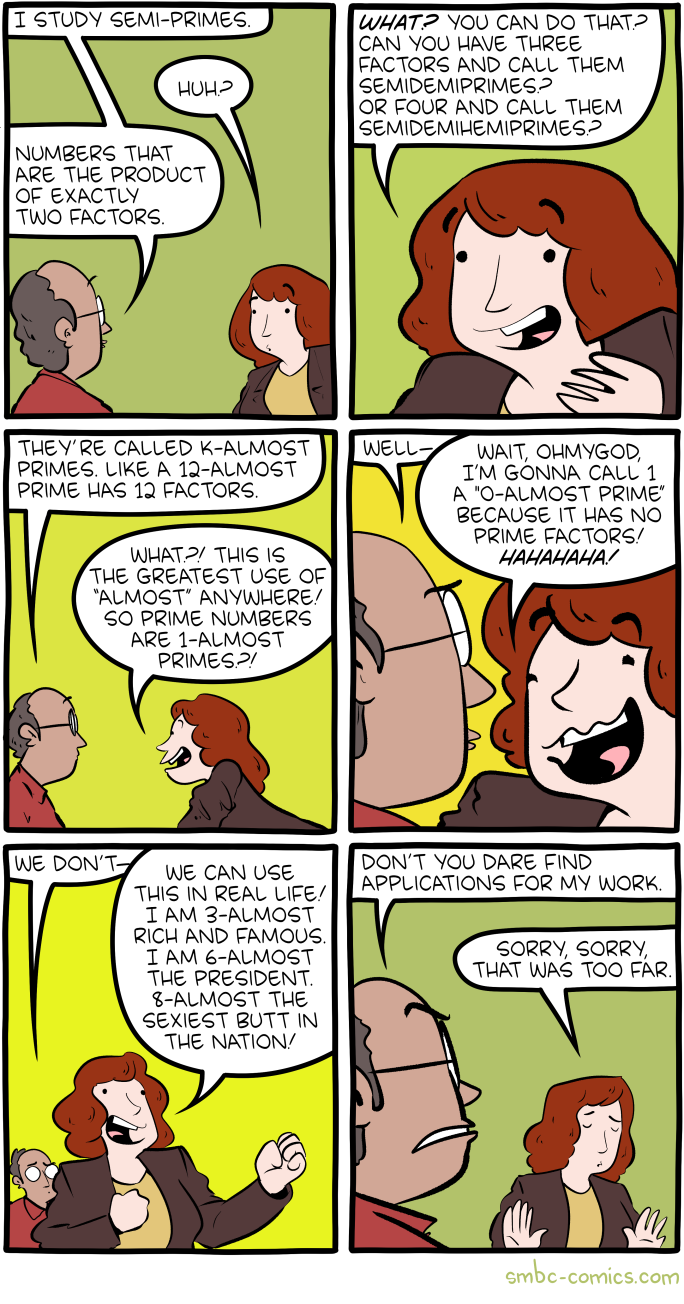
Click here to go see the bonus panel!
Hovertext:
SMBC is the 74-almost funniest webcomic.
Today's News:
If you were a patreon subscriber, you would be seeing my magnum opus at this very moment.
Michael Geist: Debating the Online Harms Act: Insights from Two Recent Panels on Bill C-63

The Online Harms Act has sparked widespread debate over the past six weeks. I’ve covered the bill in a trio of Law Bytes podcast (Online Harms, Canada Human Rights Act, Criminal Code) and participated in several panels focused on the issue. Those panels are posted below. First, a panel titled the Online Harms Act: What’s Fact and What’s Fiction, sponsored by CIJA that included Emily Laidlaw, Richard Marceau and me. It paid particular attention to the intersection between the bill and online hate.
Second, a panel titled Governing Online Harms: A Conversation on Bill C-63, sponsored by the University of Ottawa Centre for Law, Technology and Society that covered a wide range of issues and included Emily Laidlaw, Florian Martin-Bariteau, Jane Bailey, Sunil Gurmukh, and me.
The post Debating the Online Harms Act: Insights from Two Recent Panels on Bill C-63 appeared first on Michael Geist.
Ideas: The "Reconciliation" Generation: Indigenous Youth and the Future for Indigenous People
Indigenous activist Riley Yesno addresses the hopes, disappointments, accomplishments and misuses of ‘reconciliation’ in post-TRC Canada. The Anishnaabe scholar says Indigenous youth who came of age at this time are "meant to be responsible for seeing it through to its next stage."
Disquiet: Disquiet Junto Project 0642: Kick from Champagne

Each Thursday in the Disquiet Junto music community, a new compositional challenge is set before the group’s members, who then have five days to record and upload a track in response to the project instructions.
Membership in the Junto is open: just join and participate. (A SoundCloud account is helpful but not required.) There’s no pressure to do every project. The Junto is weekly so that you know it’s there, every Thursday through Monday, when your time and interest align.
Tracks are added to the SoundCloud playlist for the duration of the project. Additional (non-SoundCloud) tracks appear in the lllllll.co discussion thread.
These following instructions went to the group email list (via juntoletter.disquiet.com).
Disquiet Junto Project 0642: Kick from Champagne
The Assignment: Use carbonation to make a beat.
Step 1: Make kick drums from the sound of something carbonated.
Step 2: Make a rhythmic track (think techno, but certainly follow your own muse) using the result of Step 1.
Thanks to the folks in the Echo Chamber Slack whose discussion about techno and kicks informed this week’s project.
Tasks Upon Completion:
Label: Include “disquiet0642” (no spaces/quotes) in the name of your track.
Upload: Post your track to a public account (SoundCloud preferred but by no means required). It’s best to focus on one track, but if you post more than one, clarify which is the “main” rendition.
Share: Post your track and a description/explanation at https://llllllll.co/t/disquiet-junto-project-0642-kick-from-champagne/
Discuss: Listen to and comment on the other tracks.
Additional Details:
Length: The length is up to you.
Deadline: Monday, April 22, 2024, 11:59pm (that is: just before midnight) wherever you are.
About: https://disquiet.com/junto/
Newsletter: https://juntoletter.disquiet.com/
License: It’s preferred (but not required) to set your track as downloadable and allowing for attributed remixing (i.e., an attribution Creative Commons license).
Please Include When Posting Your Track:
More on the 642nd weekly Disquiet Junto project, Kick from Champagne — The Assignment: Use carbonation to make a beat — at https://disquiet.com/0642/
Schneier on Security: Other Attempts to Take Over Open Source Projects
After the XZ Utils discovery, people have been examining other open-source projects. Surprising no one, the incident is not unique:
The OpenJS Foundation Cross Project Council received a suspicious series of emails with similar messages, bearing different names and overlapping GitHub-associated emails. These emails implored OpenJS to take action to update one of its popular JavaScript projects to “address any critical vulnerabilities,” yet cited no specifics. The email author(s) wanted OpenJS to designate them as a new maintainer of the project despite having little prior involvement. This approach bears strong resemblance to the manner in which “Jia Tan” positioned themselves in the XZ/liblzma backdoor.
[…]
The OpenJS team also recognized a similar suspicious pattern in two other popular JavaScript projects not hosted by its Foundation, and immediately flagged the potential security concerns to respective OpenJS leaders, and the Cybersecurity and Infrastructure Security Agency (CISA) within the United States Department of Homeland Security (DHS).
The article includes a list of suspicious patterns, and another list of security best practices.
Planet Haskell: Tweag I/O: Cloud Native Computing in 2024—feeling the pulse at Kubecon
Last year, at the end of winter, we wrote our impressions of the trends and evolution of infrastructure and configuration management after attending FOSDEM and CfgMgmtCamp. We’re at it again, but with Kubecon this year, the biggest cloud native computing conference.
If you’ve never heard of cloud native computing before, it has a number of definitions online, but the simplest one is that it’s mostly about Kubernetes.
Kubecon is a huge event with thousands of attendees. The conference spanned several levels of the main convention center in Paris, with a myriad of conference rooms and a whole floor for sponsor booths. FOSDEM already felt huge compared to academic conferences, but Kubecon is even bigger.
Although the program was filled with appealing talks, we ended up spending most of our time chatting with people and visiting booths, something you can’t do as easily online.
Nix for the win
The very first morning, as we were walking around and waiting for the caffeine to kick in, we immediately spotted a Nix logo on someone’s sweatshirt. No better way to start the day than to meet with fellow Nix users!
And Nix was in general a great entry point for conversations at this year’s Kubecon. We expected it to still be an outsider at an event about container-driven technology, but the problems that “containers as a default packaging unit” can’t solve were so present that Nix’s value proposition is attuned to what everyone had on their minds anyway. In other words, Nix is now known enough as to serve as a conversation starter: the company might not use it, but many people have heard about it and were very interested to hear insights from big contributors like Tweag, the Modus Create OSPO.
Cybersecurity
Many security products were represented. Securing cloud-native applications is indeed a difficult matter, as their many layers and components expose a large attack surface.
For one, the schedule included a security track, with a fair share of talks being about SBOMs tying back into the problem of containers that ship an opaque content without inventory. Nix, as a solution to this problem, was a great conversation starter here as well, especially for fellow Nixer Matthias, who can talk for hours about how Nix is the best (and maybe only) technology for automatically deriving complete SBOMs of a piece of software, in a trustworthy manner. Our own NLNet-funded project genealogos, which does exactly that, is recently getting a lot of interest.
Besides the application code and what goes in it, another focus was avoiding misconfiguration of the cloud infrastructure layer, of the Kubernetes cluster, and anything else going into container images. Many companies propose SaaS combinations of static linters scanning the configuration files directly with various policy rules, heuristics and dynamic monitoring of secure cloud native applications. Our configuration language Nickel was very relevant here: one of its raisons d’être is to provide efficient tools (types, contracts and a powerful LSP) to detect and fix misconfigurations as early as possible. We had cool conversations around writing custom security policies as Nickel contracts with the new LSP background contract checking (introduced in 1.5) reporting non-compliance live in the editor — in that light, contracts are basically a lightweight way to program an LSP.
Internal Developer Platforms (IDPs)
IDPs were a hot topic at Kubecon. Tweag’s mission, as the OSPO of a leading software development consultancy, is to improve developer experience across the software lifecycle, which makes IDPs a natural topic for us.
An IDP is a platform - usually a web interface in practice - which glues several developer tools and services together and acts as the central entry point for most developer workflows. It’s centered around the idea of self-service, not unlike the console of cloud providers, but configurable for your exact use case and open to integrate tools across ecosystem boundaries. We already emphasized this emerging new abstraction in last year’s post. Example use cases are routinely deploying new infrastructure with just a few clicks, rather than requiring to sync and to send messages back-and-forth to the DevOps team. IDPs don’t replace other tools but offer a unified interface, usually with customized presets, to interact with repositories, internal data and infrastructure.
Backstage, an open-source IDP developed by Spotify, had its own sub-conference at Kubecon. Several products are built on top of it as well: it’s not really a ready-to-use solution but rather the engine to build a custom IDP for your company, which leaves room for turnkey offers. We feel that such integrated, centralized and simple-to-use services may become a standard in the future: think of how much GitHub (or an equivalent) is a central part of our modern workflow, but also of how many things it frustratingly can’t do (in particular infrastructure).
Cloud & AI
Many Kubernetes-based MLOps companies propose services to make it easy to deploy and manage scalable AI models in the cloud.
In the other direction, with the advent of generative AI, there was no doubt that we would see AI-based products to ease the automation of infrastructure-related tasks. We attended a demo of a multi-agent system which integrates with e.g. Slack, where you can ask a bot to perform end-to-end tasks (which includes interacting with several systems, like deploying something to the cloud, editing a Jira ticket and pushing something to a GitHub repo) or ask high-level questions, such as “which AWS users don’t have MFA enabled”.
It’s hard to tell from a demo how solid this would be in a real production system. I also don’t know if I would trust an AI agent to perform tasks without proper validation from a human (though there is a mode where confirmation is required before applying changes). There are also security concerns around having those agents run somewhere with write access to your infrastructure.
Putting those important questions aside, the demo was still quite impressive. It makes sense to automate those small boring tasks which usually require you to manually interact with several different platforms and are often quite mechanical indeed.
OSPO
We attended a Birds-of-a-Feather session on Open Source Program Offices (OSPO). While the small number of participants was a bit disappointing (between 10 and 15, compared to the size of the conference), the small group discussions were still engrossing, and we were pleased to meet people from other OSPOs as well as engineers wanting to push for an OSPO in their own company.
The generally small size OSPOs (including from very large and influential tech companies) and their low maturity from a strategic point of view was surprising to us. Many OSPOs seem to be stuck in tactical concerns, managing license and IP issues that can occur when developers open up company-owned repos. In such a situation, all OSPO members are fully occupied by the large number of requests they get. But the most interesting questions: how to share benefits and costs by working efficiently with open source communities, how to provide strategic guidance and support, and how to gain visibility in communities of interest were only addressed by few. A general concern seemed to be generally a lack of understanding by upper management about the real strategic power that an OSPO can provide. From that perspective, Tweag, although a pink unicorn as a consulting OSPO, is quite far on the maturity curve with concrete strategical and technical firepower through technical groups, and our open-source portfolio (plus the projects that we contribute to but aren’t ours).
Concluding words
Kubecon was a great experience, and we’re looking forward to the next one. We are excited about the advent of Internal Developer Platforms and the concept of self-serving infrastructure, which are important aspects of developer experience.
On the technological side, the cloud-native world seems to be dominated by Kubernetes with Helm charts and YAML, and Docker, while the technologies we believe in and are actively developing are still outsiders in the space (of course they aren’t a full replacement for what currently exists, but they could fill many gaps). I’m thinking in particular about Nix (and more generally about declarative, hermetic and reproducible builds and deployments) and Nickel (better configuration languages and management tools). But, conversation after conversation, conference after conference, we’re seeing more and more interests in new paradigms, sometimes because those technologies are best equipped - by far - to solve problems that are on everyone’s radar (e.g. software traceability through SBOMs with Nix) thanks to their different approach.
BOOOOOOOM! – CREATE * INSPIRE * COMMUNITY * ART * DESIGN * MUSIC * FILM * PHOTO * PROJECTS: “Cobalt Blues” by Artist Karen Ösp Pálsdóttir
Artist Bio:Karen Ösp Pálsdóttir (b.1992) received her BFA from the Maryland Institute College of Art (MICA) in 2013. Her paintings have been exhibited in galleries in New York, Baltimore, Washington DC, Boston, Reykjavík, London, Barcelona, and Paris. Karen’s paintings have been featured in various publications such as New American Paintings, Create! Magazine, Tibia Magazine, SFMOMA, Hyperallergic, and El País. Pálsdóttir´s work explores various subjects through a Cobalt Blue lens in her most recent monochromatic oil paintings.
Statement: Inspired by the delicate interplay of elasticity and depth, Karen’s work explores the nuanced language of cobalt blue. Through the range of cobalt blue’s dark, velvety hues and soft zeniths, each composition becomes part of a larger exploration of temporality and impermanence. This “modern, Improved Blue” becomes a tactile experience in monochromatic simplicity and invites the viewer to peer through a singular lens, akin to an optical filter. The Blue Star Fern, a reoccurring collaborator, often emerges as a fusion of transparency and distortion. It stands as a quiet observer of the evolving lucidity of the human condition and the dance between what is and what might be.








Ideas: The history of bombing civilians — and why it’s still a military tactic
The bombing of civilians has been called one of the "great scandals" of modern warfare. So why, despite nearly a century of drafting laws and signing conventions protecting the sanctity of human life, does bombing civilians remain a widespread military tactic?
Tea Masters: Purple Da Yi 2003 vs loose Gushu from early 2000s
Both have aged dry scents, but storage smells are still more prevalent on the loose puerh, because it has spent less time in my own (relatively) dry Taiwanese storage. The Da Yi smells more woody, while the loose puerh smells more of camphor.
The taste also has lots of similarities, but I find the loose gushu a little bit thicker in taste and more harmonious. So, the Da Yi has some strong points, but the loose gushu still comes on top if your focus is purity and a thick gushu taste. And the price of the loose puerh also makes it a winner!
Ideas: Humboldt's Ghost, Pt 2: The meaning of education
IDEAS continues to explore Wilhelm von Humboldt’s public education system with guests, including acclaimed author Gabor Maté, who is a former English teacher. Is this 200-year-old system equipped to meet the challenging demands of the 21st century? And does it still reflect Humboldt’s ideals, especially at the university level? *This is part two of a two-part series.
The Universe of Discourse: Try it and see
I thought about this because of yesterday's article about the person who needed to count the 3-colorings of an icosahedron, but didn't try constructing any to see what they were like.
Around 2015 Katara, then age 11, saw me writing up my long series of articles about the Cosmic Call message and asked me to explain what the mysterious symbols meant. (It's intended to be a message that space aliens can figure out even though they haven't met us.)

I said “I bet you could figure it out if you tried.” She didn't believe me and she didn't want to try. It seemed insurmountable.
“Okay,” I said, handing her a printed copy of page 1. “Sit on the chaise there and just look at it for five minutes without talking or asking any questions, while I work on this. Then I promise I'll explain everything.”
She figured it out in way less than five minutes. She was thrilled to discover that she could do it.
I think she learned something important that day: A person can accomplish a lot with a few minutes of uninterrupted silent thinking, perhaps more than they imagine, and certainly a lot more than if they don't try.
I think there's a passage somewhere in Zen and the Art of Motorcycle Maintenance about how, when you don't know what to do next, you should just sit with your mouth shut for a couple of minutes and see if any ideas come nibbling. Sometimes they don't. But if there are any swimming around, you won't catch them unless you're waiting for them.
CreativeApplications.Net: gr1dflow – Exploring recursive ontologies

gr1dflow is a collection of artworks created through code, delving into the world of computational space. While the flowing cells and clusters showcase the real-time and dynamic nature of the medium, the colours and the initial configuration of the complex shapes are derived from blockchain specific metadata associated with the collection.
Submitted by: 0xStc
Category: Member Submissions
Tags: audiovisual / blockchain / generative / glsl / NFT / realtime / recursion
People: Agoston Nagy
Michael Geist: The Law Bytes Podcast, Episode 199: Boris Bytensky on the Criminal Code Reforms in the Online Harms Act

The Online Harms Act – otherwise known as Bill C-63 – is really at least three bills in one. The Law Bytes podcast tackled the Internet platform portion of the bill last month in an episode with Vivek Krishnamurthy and then last week Professor Richard Moon joined to talk about the return of Section 13 of the Canada Human Rights Act. Part three may the most controversial: the inclusion of Criminal Code changes that have left even supporters of the bill uncomfortable.
Boris Bytensky of the firm Bytensky Shikhman has been a leading Canadian criminal law lawyer for decades and currently serves as President of the Criminal Lawyers’ Association. He joins the podcast to discuss the bill’s Criminal Code reforms as he identifies some of the practical implications that have thus far been largely overlooked in the public debate.
The podcast can be downloaded here, accessed on YouTube, and is embedded below. Subscribe to the podcast via Apple Podcast, Google Play, Spotify or the RSS feed. Updates on the podcast on Twitter at @Lawbytespod.
Credits:
W5, A Shocking Upsurge of Hate Crimes in Canada
The post The Law Bytes Podcast, Episode 199: Boris Bytensky on the Criminal Code Reforms in the Online Harms Act appeared first on Michael Geist.
Tea Masters: Another puerh comparison: Yiwu from 2003 vs. DaYi purple cake from 2003
 |
| Yiwu 2003 vs DaYi purple 2003 |
Conclusion: During the CNNP era, tea drinkers didn't have much choice. There were only few puerh factories and they produced almost exclusively cakes that were mixed leaves. A few years later, in 2003, more choice became available. Those who trusted my advice back then have been rewarded with a puerh that has remained superior in quality over the years and that still tastes more harmonious than the Purple Da Yi of 2003.
Project Gus: Unremarkable Kona Progress
I've been holding off posting as I haven't had any major breakthroughs with the Kona Electric reversing project. However, I haven't sat totally idle...
On-car testing
Last post the Kona motor started to spin, but without a load attached it was spinning out of control! Even in Neutral, the motor …
The Shape of Code: Average lines added/deleted by commits across languages
Are programs written in some programming language shorter/longer, on average, than when written in other languages?
There is a lot of variation in the length of the same program written in the same language, across different developers. Comparing program length across different languages requires a large sample of programs, each implemented in different languages, and by many different developers. This sounds like a fantasy sample, given the rarity of finding the same specification implemented multiple times in the same language.
There is a possible alternative approach to answering this question: Compare the size of commits, in lines of code, for many different programs across a variety of languages. The paper: A Study of Bug Resolution Characteristics in Popular Programming Languages by Zhang, Li, Hao, Wang, Tang, Zhang, and Harman studied 3,232,937 commits across 585 projects and 10 programming languages (between 56 and 60 projects per language, with between 58,533 and 474,497 commits per language).
The data on each commit includes: lines added, lines deleted, files changed, language, project, type of commit, lines of code in project (at some point in time). The paper investigate bug resolution characteristics, but does not include any data on number of people available to fix reported issues; I focused on all lines added/deleted.
Different projects (programs) will have different characteristics. For instance, a smaller program provides more scope for adding lots of new functionality, and a larger program contains more code that can be deleted. Some projects/developers commit every change (i.e., many small commit), while others only commit when the change is completed (i.e., larger commits). There may also be algorithmic characteristics that affect the quantity of code written, e.g., availability of libraries or need for detailed bit twiddling.
It is not possible to include project-id directly in the model, because each project is written in a different language, i.e., language can be predicted from project-id. However, program size can be included as a continuous variable (only one LOC value is available, which is not ideal).
The following R code fits a basic model (the number of lines added/deleted is count data and usually small, so a Poisson distribution is assumed; given the wide range of commit sizes, quantile regression may be a better approach):
alang_mod=glm(additions ~ language+log(LOC), data=lc, family="poisson")
dlang_mod=glm(deletions ~ language+log(LOC), data=lc, family="poisson")
Some of the commits involve tens of thousands of lines (see plot below). This sounds rather extreme. So two sets of models are fitted, one with the original data and the other only including commits with additions/deletions containing less than 10,000 lines.
These models fit the mean number of lines added/deleted over all projects written in a particular language, and the models are multiplicative. As expected, the variance explained by these two factors is small, at around 5%. The two models fitted are (code+data):
 or
or  , and
, and  or
or  , where the value of
, where the value of  is listed in the following table, and
is listed in the following table, and  is the number of lines of code in the project:
is the number of lines of code in the project:
Original 0 < lines < 10000
Language Added Deleted Added Deleted
C 1.0 1.0 1.0 1.0
C# 1.7 1.6 1.5 1.5
C++ 1.9 2.1 1.3 1.4
Go 1.4 1.2 1.3 1.2
Java 0.9 1.0 1.5 1.5
Javascript 1.1 1.1 1.3 1.6
Objective-C 1.2 1.4 2.0 2.4
PHP 2.5 2.6 1.7 1.9
Python 0.7 0.7 0.8 0.8
Ruby 0.3 0.3 0.7 0.7
These fitted models suggest that commit addition/deletion both increase as project size increases, by around  , and that, for instance, a commit in Go adds 1.4 times as many lines as C, and delete 1.2 as many lines (averaged over all commits). Comparing adds/deletes for the same language: on average, a Go commit adds
, and that, for instance, a commit in Go adds 1.4 times as many lines as C, and delete 1.2 as many lines (averaged over all commits). Comparing adds/deletes for the same language: on average, a Go commit adds  lines, and deletes
lines, and deletes  lines.
lines.
There is a strong connection between the number of lines added/deleted in each commit. The plot below shows the lines added/deleted by each commit, with the red line showing a fitted regression model  (code+data):
(code+data):
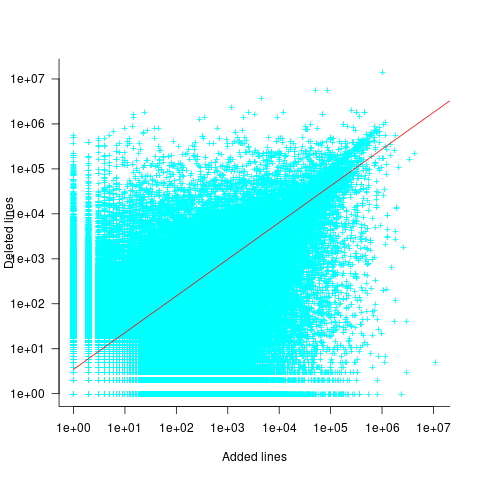
What other information can be included in a model? It is possible that project specific behavior(s) create a correlation between the size of commits; the algorithm used to fit this model assumes zero correlation. The glmer function, in the R package lme4, can take account of correlation between commits. The model component (language | project) in the following code adds project as a random effect on the language variable:
del_lmod=glmer(deletions ~ language+log(LOC)+(language | project), data=lc_loc, family=poisson)
It takes around 24hr of cpu time to fit this model, which means I have not done much experimentation...
The Universe of Discourse: Stuff that is and isn't backwards in Australia
I recently wrote about things that are backwards in Australia. I made this controversial claim:
The sun in the Southern Hemisphere moves counterclockwise across the sky over the course of the day, rather than clockwise. Instead of coming up on the left and going down on the right, as it does in the Northern Hemisphere, it comes up on the right and goes down on the left.
Many people found this confusing and I'm not sure our minds met on this. I am going to try to explain and see if I can clear up the puzzles.
“Which way are you facing?” was a frequent question. “If you're facing north, it comes up on the right, not the left.”
(To prevent endless parenthetical “(in the Northern Hemisphere)” qualifications, the rest of this article will describe how things look where I live, in the northern temperate zones. I understand that things will be reversed in the Southern Hemisphere, and quite different near the equator and the poles.)
Here's what I think the sky looks like most of the day on most of the days of the year:
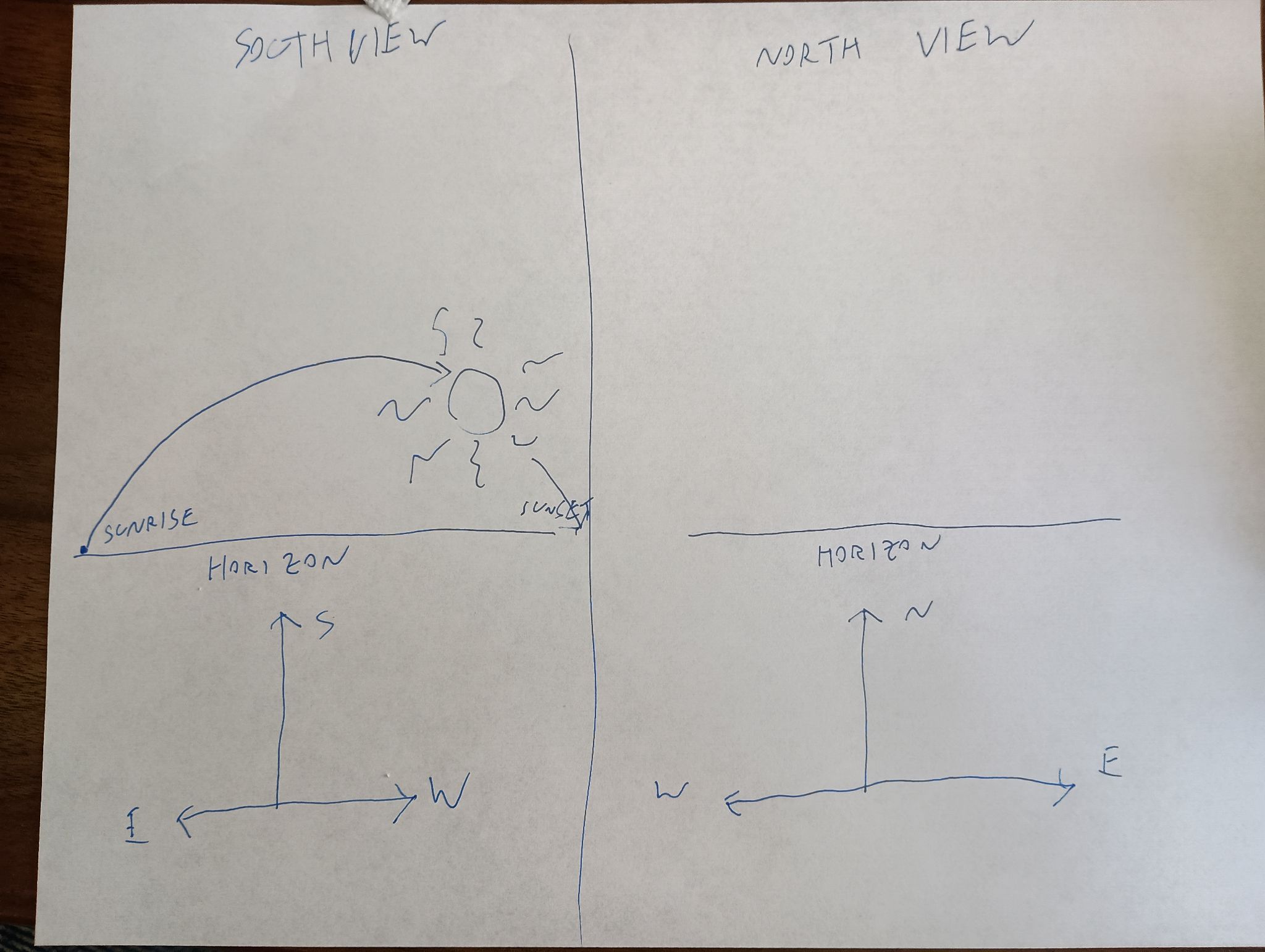
The sun is in the southern sky through the entire autumn, winter, and spring. In summer it is sometimes north of the celestial equator, for up to a couple of hours after sunrise and before sunset, but it is still in the southern sky most of the time. If you are watching the sun's path through the sky, you are looking south, not north, because if you are looking north you do not see the sun, it is behind you.
Some people even tried to argue that if you face north, the sun's path is a counterclockwise circle, rather than a clockwise one. This is risible. Here's my grandfather's old grandfather clock. Notice that the hands go counterclockwise! You study the clock and disagree. They don't go counterclockwise, you say, they go clockwise, just like on every other clock. Aha, but no, I say! If you were standing behind the clock, looking into it with the back door open, then you would clearly see the hands go counterclockwise! Then you kick me in the shin, as I deserve.
Yes, if you were to face away from the sun, its path could be said to be counterclockwise, if you could see it. But that is not how we describe things. If I say that a train passed left to right, you would not normally expect me to add “but it would have been right to left, had I been facing the tracks”.
At least one person said they had imagined the sun rising directly ahead, then passing overhead, and going down in back. Okay, fair enough. You don't say that the train passed left to right if you were standing on the tracks and it ran you down.
Except that the sun does not pass directly overhead. It only does that in the tropics. If this person were really facing the sun as it rose, and stayed facing that way, the sun would go up toward their right side. If it were a train, the train tracks would go in a big curve around their right (south) side, from left to right:
Mixed gauge track (950 and 1435mm) at Sassari station, Sardinia, 1996 by user Afterbrunel, CC BY-SA 3.0 DEED, via Wikimedia Commons. I added the big green arrows.
After the train passed, it would go back the other way, but they wouldn't be able see it, because it would be behind them. If they turned around to watch it go, it would still go left to right:
And if they were to turn to follow it over the course of the day, they would be turning left to right the whole time, and the sun would be moving from left to right the whole time, going up on the left and coming down on the right, like the hands of a clock — “clockwise”, as it were.
One correspondent suggested that perhaps many people in technologically advanced countries are not actually familiar with how the sun and moon move, and this was the cause of some of the confusion. Perhaps so, it's certainly tempting to dismiss my critics as not knowing how the sun behaves. The other possibility is that I am utterly confused. I took Observational Astronomy in college twice, and failed both times.
Anyway, I will maybe admit that “left to right” was unclear. But I will not recant my claim that the sun moves clockwise. E pur si muove in senso orario.
Sundials
Here I was just dead wrong. I said:
In the Northern Hemisphere, the shadow of a sundial proceeds clockwise, from left to right.
Absolutely not, none of this is correct. First, “left to right”. Here's a diagram of a typical sundial:

It has a sticky-up thing called a ‘gnomon’ that casts a shadow across the numbers, and the shadow moves from left to right over the course of the day. But obviously the sundial will work just as well if you walk around and look at it from the other side:

It still goes clockwise, but now clockwise is right to left instead of left to right.
It's hard to read because the numerals are upside down? Fine, whatever:

Here, unlike with the sun, “go around to the other side” is perfectly reasonable.
Talking with Joe Ardent, I realized that not even “clockwise” is required for sundials. Imagine the south-facing wall of a building, with the gnomon sticking out of it perpendicular. When the sun passes overhead, the gnomon will cast a shadow downwards on the wall, and the downward-pointing shadow will move from left to right — counterclockwise — as the sun makes its way from east to west. It's not even far-fetched. Indeed, a search for “vertical sundials” produced numerous examples:

Sundial on the Moot Hall by David Dixon, CC BY 2.0 https://creativecommons.org/licenses/by/2.0, via Wikimedia Commons and Geograph.
Winter weather on July 4
Finally, it was reported that there were complaints on Hacker News that Australians do not celebrate July 4th. Ridiculous! All patriotic Americans celebrate July 4th.
The Universe of Discourse: Stuff that is backwards in Australia
I thought at first was going to be kind of a dumb article, because it was just going to be a list of banal stuff like:
- When it's day here, it's night there, and vice versa
but a couple of years back I was rather startled to realize that in the Southern Hemisphere the sun comes up on the right and goes counterclockwise through the sky instead of coming up on the left and going clockwise as I have seen it do all my life, and that was pretty interesting.
Then more recently I was thinking about it more carefully and I was stunned when I realized that the phases of the moon go the other way. So I thought I'd should actually make the list, because a good deal of it is not at all obvious. Or at least it wasn't to me!
When it's day here, it's night there, and vice versa. (This isn't a Southern Hemisphere thing, it's an Eastern Hemisphere thing.)
When it's summer here, it's winter there, and vice versa. Australians celebrate Christmas by going to the beach, and July 4th with sledding and patriotic snowball fights.
Australia's warmer zones are in the north, not the south. Their birds fly north for the winter. But winter is in July, so the reversals cancel out and birds everywhere fly south in September and October, and north in March and April, even though birds can't read.
The sun in the Southern Hemisphere moves counterclockwise across the sky over the course of the day, rather than clockwise. Instead of coming up on the left and going down on the right, as it does in the Northern Hemisphere, it comes up on the right and goes down on the left.
In the Northern Hemisphere, the shadow of a sundial proceeds clockwise, from left to right. (This is the reason clock hands also go clockwise: for backward compatibility with sundials.) But in the Southern Hemisphere, the shadow on a sundial goes counterclockwise.
In the Southern Hemisphere, the designs on the moon appear upside-down compared with how they look in the Northern Hemisphere. Here's a picture of the full moon as seen from the Northern Hemisphere. The big crater with the bright rays that is prominent in the bottom half of the picture is Tycho.
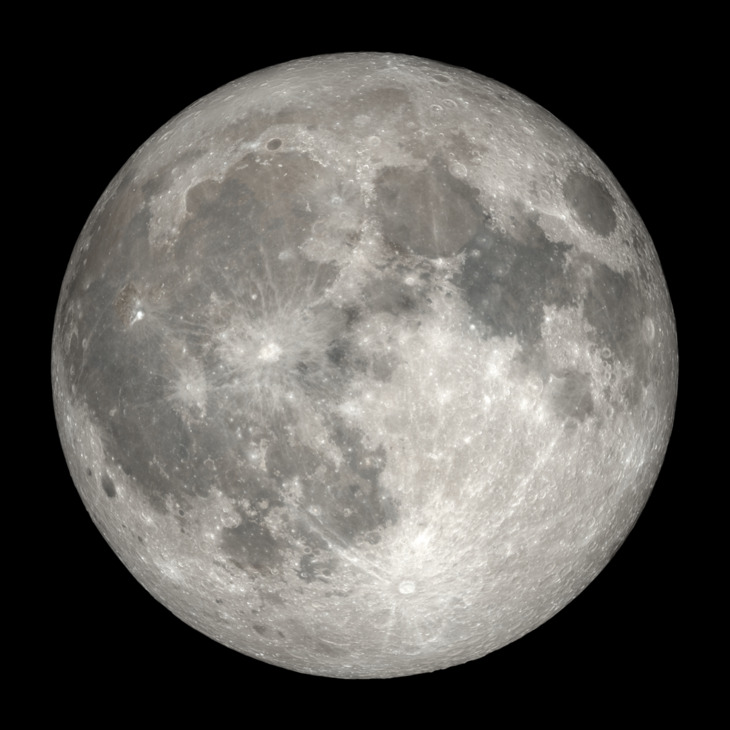
In the Southern Hemisphere the moon looks like this, with Tycho on top:
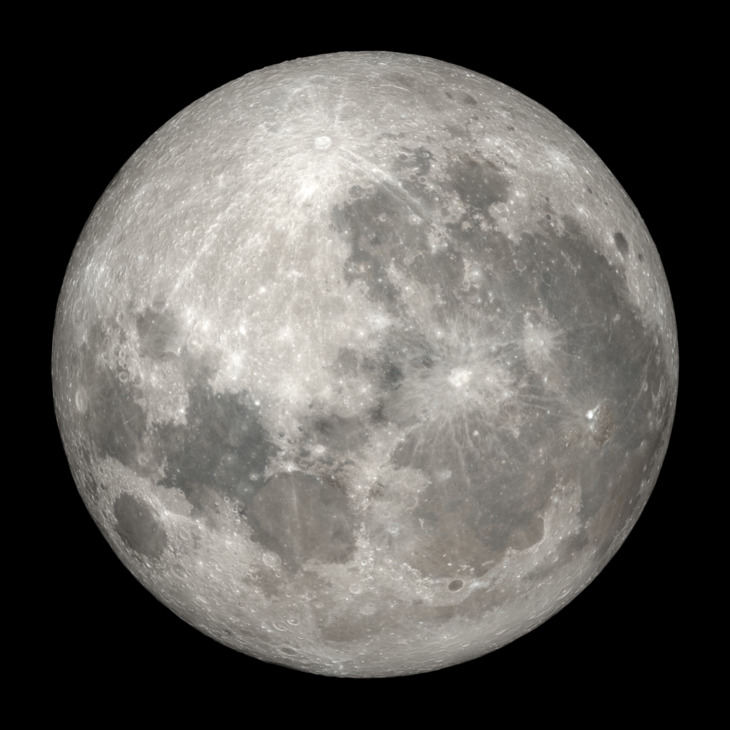
Australians see the moon upside-down because their heads are literally pointing in the opposite direction.
For the same reason, the Moon's phases in the Southern Hemisphere sweep from left to right instead of from right to left. In the Northern Hemisphere they go like this as the month passes from new to full:





And then in the same direction from full back to new:





But in the Southern Hemisphere the moon changes from left to right instead:





And then:





Unicode U+263D and U+263E are called
FIRST QUARTER MOON☽ andLAST QUARTER MOON☾ , respectively, and are depicted Northern Hemisphere style. (In the Southern Hemisphere, ☽ appears during the last quarter of the month, not the first.) Similarly the emoji U+1F311 through U+1F318, 🌑🌒🌓🌔🌕🌖🌗🌘 are depicted in Northern Hemisphere order, and have Northern Hemisphere descriptions like “🌒 waxing crescent moon”. In the Southern Hemisphere, 🌒 is actually a waning crescent.In the Northern Hemisphere a Foucault pendulum will knock down the pins in clockwise order, as shown in the picture. (This one happens to be in Barcelona.) A Southern Hemisphere Foucault pendulum will knock them down in counterclockwise order, because the Earth is turning the other way, as viewed from the fulcrum of the pendulum.

Northern Hemisphere tornadoes always rotate counterclockwise. Southern Hemisphere tornadoes always rotate clockwise.
Dishonorable mention
As far as I know the thing about water going down the drain in one direction or the other is not actually true.
Addendum 20240414
Several people took issue with some of the claims in this article, and the part about sundials was completely wrong. I wrote a followup.
Planet Lisp: Paolo Amoroso: Testing the Practical Common Lisp code on Medley
When the Medley Interlisp Project began reviving the system around 2020, its Common Lisp implementation was in the state it had when commercial development petered out in the 1990s, mostly prior to the ANSI standard.
Back then Medley Common Lisp mostly supported CLtL1 plus CLOS and the condition system. Some patches submitted several years later to bring the language closer to CLtL2 needed review and integration.
Aside from these general areas there was no detailed information on what Medley missed or differed from ANSI Common Lisp.
In late 2021 Larry Masinter proposed to evaluate the ANSI compatibility of Medley Common Lisp by running the code of popular Common Lisp books and documenting any divergences. In March of 2024 I set to work to test the code of the book Practical Common Lisp by Peter Seibel.
I went over the book chapter by chapter and completed a first pass, documenting the effort in a GitHub issue and a series of discussion posts. In addition I updated a running list of divergences from ANSI Common Lisp.
Methodology
Part of the code of the book is contained in the examples in the text and the rest in the downloadable source files, which constitute some more substantial projects.
To test the code on Medley I evaluated the definitions and expressions at a Xerox Common Lisp Exec, noting any errors or differences from the expected outcomes. When relevant source files were available I loaded them prior to evaluating the test expressions so that any required definitions and dependencies were present. ASDF hasn't been ported to Medley, so I loaded the files manually.
Adapting the code
Before running the code I had to apply a number of changes. I filled in any missing function and class definitions the book leaves out as incidental to the exposition. This also involved adding appropriate function calls and object instantiations to exercise the definitions or produce the expected output.
The source files of the book needed adaptation too due to the way Medley handles pure Common Lisp files.
Skipped code
The text and source files contain also code I couldn't run because some features are known to be missing from Medley, or key dependencies can't be fulfilled. For example, a few chapters rely on the AllegroServe HTTP server which doesn't run on Medley. Although Medley does have a XNS network stack, providing the TCP/IP network functions AllegroServe assumes would be a major project.
Some chapters depend on code in earlier chapters that uses features not available in Medley Common Lisp, so I had to skip those too.
Findings
Having completed the first pass over Practical Common Lisp, my initial impression is Medley's implementation of Common Lisp is capable and extensive. It can run with minor or no changes code that uses most basic and intermediate Common Lisp features.
The majority of the code I tried ran as expected. However, this work did reveal significant gaps and divergences from ANSI.
To account for the residential environment and other peculiarities of Medley, packages need to be defined in a specific way. For example, some common defpackage keyword arguments differ from ANSI. Also, uppercase strings seem to work better than keywords as package designators.
As for the gaps the loop iteration macro, symbol-macrolet, the #p reader macro, and other features turned out to be missing or not work.
While the incompatibilities with ANSI Common Lisp are relativaly easy to address or work around, what new users may find more difficult is understanding and using the residential environment of Medley.
Bringing Medley closer to ANSI Common Lisp
To plug the gaps this project uncovered Larry ported or implemented some of the missing features and fixed a few issues.
He ported a loop implementation which he's enhancing to add missing functionality like iterating over hash tables. Iterating over packages, which loop lacks at this time, is trickier. More work went into adding #p and an experimental symbol-macrolet.
Reviewing and merging the CLtL2 patches is still an open issue, a major project that involves substantial effort.
Future work and conclusion
When the new features are ready I'll do a second pass to check if more of the skipped code runs. Another outcome of the work may be the beginning of a test suite for Medley Common Lisp.
Regardless of the limitations, what the project highlighted is Medley is ready as a development environment for writing new Common Lisp code, or porting libraries and applications of small to medium complexity.
Discuss... Email | Reply @amoroso@fosstodon.org
MattCha's Blog: 1999-2003 Mr Chen’s JiaJi Green Mark
This 1999-2003 Mr Chen’s JaiJi Green Ink sample came free with the purchase of the 1999 Mr Chen Daye ZhengShan MTF Special Order. I didn’t go to the site so blind to the price and description and tried it after a session of the ZhongShan MTF Special Order…
Dry leaves have a dry woody dirt faint taste.
Rinsed leaves have a creamy sweet odour.
First infusion has a sweet watery onset there is a return of sweet woody slight warm spice. Sweet, simple, watery and clean in this first infusion.
Second infusion has a sweet watery simple woody watery sweet taste. Slight woody incense and slight fresh fruity taste. Cooling mouth. Sweet bread slight faint candy aftertaste. Slight drying mouthfeel.
Third infusions has a woody dry wood onset with a dry woody sweet kind of taste. The return is a bready candy with sweet aftertaste. Tastes faintly like red rope licorice. Dry mouthfeeling now. Somewhat relaxing qi. Mild but slight feel good feeling. Mild Qi feeling.
Fourth infusion is left to cool and is creamy sweet watery with a faint background wood and even faint incense. Simple sweet clean tastes. Thin dry mouthfeel.
Fifth infusion is a slight creamy sweet watery slight woody simple sweet pure tasting. left to cool is a creamy sweet some lubricant watery sweetness.
Sixth has an incense creamy sweet talc woody creamy more full sweetness initially. Creamy sweetness watery mild Qi. Enjoyable and easy drinking puerh.
Seventh has a sweet woody leaf watery taste with an incense woody watery base. The mouthfeel is slightly dry and qi is pretty mild and agreeable.
Eighth infusion is a woody watery sweet with subtle incense warm spice. Mild dry mouthfeel.
Ninth infusion has a woody incense onset with sweet edges. Dry flat mouthfeel and mild qi.
Tenth I put into long mug steepings… it has a dirt woody bland slight bitter taste… not much for sweetness anymore.
Overnight infusion has a watery bland, slight dirt, slight sweet insipid taste.
This is a pretty simple and straightforward dry stored aged sheng. Sweet woody incense taste with mild dry and mild relaxing feel good qi. On a busy day at work I appreciated its steady aged simplicity. I go to the site and look at the price and description and I couldn’t really agree more. The price is a bit lower than I thought and the description is dead on!
Vs 1999 Mr Chen’s Daye ZhengShan MTF Special Order- despite coming from the same collector, being both dry stored, and being the same approx age these are very different puerh. The MTF special order is much more complex in taste, very very sweet and has much more powerful space out Qi. This JaiJi Green ink is satisfying enough but not so fancy complex or mind-bending. It’s more of an aged dry storage drinker.
After a session of the 1999 Mr Chen Daye ZhengShan I did a back to back with 2001 Naked Yiwu from TeasWeLike but they are also completely differ puerh… the Nake Yiwu was much more condensed, present, and powerful in taste with sweet tastes, resin wood, and smoke incense. It’s more aggressive and forward and feels less aged than the 1999 ZhengShan MTF Special Order but in the same way it can be more satisfying especially for the price which seems like a pretty good deal. I suppose all three of these are good value dispite the totally different vibes of each.
Pictured is Left 2001 Naked Yiwu from TeasWeLike, Middle 1999 Mr Chen’s Daye ZhengShan MTF, Right 2001-1999 Me Chen’s JiaJi Green Ink.
Peace
Daniel Lemire's blog: Science and Technology links (April 13 2024)
-
-
- Our computer hardware exchange data using a standard called PCI Express. Your disk, your network and your GPU are limited by what PCI Express can do. Currently, it means that you are limited to a few gigabytes per second of bandwidth. PCI Express is about to receive a big performance boost in 2025 when PCI Express 7 comes out: it will support bandwidth of up to 512 GB/s. That is really, really fast. It does not follow that your disks and graphics are going to improve very soon, but it provides the foundation for future breakthroughs.
- Sperm counts are down everywhere and the trend is showing no sign of slowing down. There are indications that it could be related to the rise in obesity.
- A research paper by Burke et al. used a model to predict that climate change could reduce world GPD (the size of the economy) by 23%. For reference, world GDP grows at a rate of about 3% a year (+/- 1%) so that a cost of 23% is about equivalent to 7 to 8 years without growth. It is much higher than prior predictions. Barket (2024) questions these results:
It is a complicated paper that makes strong claims. The authors use thousands of lines of code to run regressions containing over 500 variables to test a nonlinear model of temperature and growth for 166 countries and forecast economic growth out to the year 2100. Careful analysis of their work shows that they bury inconvenient results, use misleading charts to confuse readers, and fail to report obvious robustness checks. Simulations suggest that the statistical significance of their results is inflated. Continued economic growth at levels similar to what the world has experienced in recent years would increase the level of future economic activity by far more than Nordhaus’ (2018) estimate of the effect of warming on future world GDP. If warming does not affect the rate of economic growth, then the world is likely to be much richer in the future, with or without warming temperatures.
- The firm McKinsey reports finding statistically significant positive relations between the industry-adjusted earnings and the racial/ethnic diversity of their executives. Green and Hand (2024) fail to reproduce these results. They conclude: despite the imprimatur given to McKinsey’s studies, their results should not be relied on to support the view that US publicly traded firms can expect to deliver improved financial performance if they increase the racial/ethnic diversity of their executives.
- Corinth and Larrimore (2024) find that after adjusting for hours worked, Generation X and Millennials experienced a greater intergenerational increase in real market income than baby boomers.
-
Daniel Lemire's blog: Greatest common divisor, the extended Euclidean algorithm, and speed!
We sometimes need to find the greatest common divisor between two integers in software. The fastest way to compute the greatest common divisor might be the binary Euclidean algorithm. In C++20, it can be implemented generically as follows:
template <typename int_type> int_type binary_gcd(int_type u, int_type v) { if (u == 0) { return v; } if (v == 0) { return u; } auto shift = std::countr_zero(u | v); u >>= std::countr_zero(u); do { v >>= std::countr_zero(v); if (u > v) { std::swap(u, v); } v = v - u; } while (v != 0); return u << shift; }
The std::countr_zero function computes the “number of trailing zeroes” in an integer. A key insight is that this function often translates into a single instruction on modern hardware.
Its computational complexity is the number of bits in the largest of the two integers.
There are many variations that might be more efficient. I like an approach proposed by Paolo Bonzini which is simpler as it avoid the swap:
int_type binary_gcd_noswap(int_type u, int_type v) { if (u == 0) { return v; } if (v == 0) { return u; } auto shift = std::countr_zero(u | v); u >>= std::countr_zero(u); do { int_type t = v >> std::countr_zero(v); if (u > t) v = u - t, u = t; else v = t - u; } while (v != 0); return u << shift; }
The binary Euclidean algorithm is typically faster than the textbook Euclidean algorithm which has to do divisions (a slow operation), although the resulting code is pleasantly short:
template <typename int_type> int_type naive_gcd(int_type u, int_type v) { return (u % v) == 0 ? v : naive_gcd(v, u % v); }
There are cases where the naive GCD algorithm is faster. For example, if v divides u, which is always the case when v is 1, then the naive algorithm returns immediately whereas the binary GCD algorithm might require many steps if u is large.
I found interesting that there is a now a std::gcd function in the C++ standard library so you may not want to implement your own greatest-common-divisor if you are programming in modern C++.
For the mathematically inclined, there is also an extended Euclidean algorithm. It also computes the greatest common divisor, but also the Bézout coefficients. That is, given two integers a and b, it finds integers x and y such that x * a + y * b = gcd(a,b). I must admit that I never had any need for the extended Euclidean algorithm. Wikipedia says that it is useful to find multiplicative inverses in a module space, but the only multiplicative inverses I ever needed were computed with a fast Newton algorithm. Nevertheless, we might implement it as follows:
template <typename int_type> struct bezout { int_type gcd; int_type x; int_type y; }; // computes the greatest common divisor between a and b, // as well as the Bézout coefficients x and y such as // a*x + b*y = gcd(a,b) template <typename int_type> bezout<int_type> extended_gcd(int_type u, int_type v) { std::pair<int_type, int_type> r = {u, v}; std::pair<int_type, int_type> s = {1, 0}; std::pair<int_type, int_type> t = {0, 1}; while (r.second != 0) { auto quotient = r.first / r.second; r = {r.second, r.first - quotient * r.second}; s = {s.second, s.first - quotient * s.second}; t = {t.second, t.first - quotient * t.second}; } return {r.first, s.first, t.first}; }
There is also a binary version of the extended Euclidean algorithm although it is quite a bit more involved and it is not clear that it is can be implemented at high speed, leveraging fast instructions, when working on integers that fit in general-purpose registers. It is may beneficial when working with big integers. I am not going to reproduce my implementation, but it is available in my software repository.
To compare these functions, I decided to benchmark them over random 64-bit integers. I found interesting that the majority of pairs of random integers (about two thirds) were coprime, meaning that their greatest common divisor is 1. Mathematically, we would expect the ratio to be 6/pi2 which is about right empirically. At least some had non-trivial greatest common divisors (e.g., 42954).
Computing the greatest common divisor takes hundreds of instructions and hundreds of CPU cycle. If you somehow need to do it often, it could be a bottleneck.
I find that the std::gcd implementation which is part of the GCC C++ library under Linux is about as fast as the binary Euclidean function I presented. I have not looked at the implementation, but I assume that it might be well designed. The version that is present on the C++ library present on macOS (libc++) appears to be the naive implementation. Thus there is an opportunity to improve the lib++ implementation.
The extended Euclidean-algorithm implementation runs at about the same speed as a naive regular Euclidean-algorithm implementation, which is what you would expect. My implementation of the binary extended Euclidean algorithm is quite a bit slower and not recommended. I expect that it should be possible to optimize it further.
| function | GCC 12 + Intel Ice Lake | Apple LLVM + M2 |
|---|---|---|
| std::gcd | 7.2 million/s | 7.8 million/s |
| binary | 7.7 million/s | 12 million/s |
| binary (no swap) | 9.2 million/s | 14 million/s |
| extended | 2.9 million/s | 7.8 million/s |
| binary ext. | 0.7 million/s | 2.9 million/s |
It may seem surprising that the extended Euclidean algorithm runs at the same speed as std::gcd on some systems, despite the fact that it appears to do more work. However, the computation of the Bézout coefficient along with the greatest common divisor is not a critical path, and can be folded in with the rest of the computation on a superscalar processor… so the result is expected.
As part of the preparation of this blog post, I had initially tried writing a C++ module. It worked quite well on my MacBook. However, it fell part under Linux with GCC, so I reverted it back. I was quite happy at how using modules made the code simpler, but it is not yet sufficiently portable.
Credit: Thanks to Harold Aptroot for a remark about the probability of two random integers being prime.
MattCha's Blog: Complex Sweet Dry Storage: 1999 Mr Chen’s Daye ZhengShan MTF Special Order
Dry leaves have a sweet slight marsh peat odour to them.
Rinsed leaf has a leaf slight medicinal raison odour.
First infusion has a purfume medicinal fruity sweetness. There are notes of fig, cherries, longgan fruit nice complex onset with a were dry leaf base.
Second infusion has a woody slight purfume medical sweet cherry and fig taste. Nice dry storage base of slight mineral and leaf taste. Mouthfeel is a bit oily at first but slight silty underneath. There is a soft lingering sweetness returning of fruit with a woody base taste throughout. Slight warm chest with spacy head feeling.
Third infusion has a leafy woody maple syrup onset that gets a bit sweeter on return the sweetness is syrupy like stewed fruity with a leaf dry woody background that is throughout the profile. A more fruity pop of taste before some cool camphor on the breath. A silty almost dry mouthfeeling emerges after the initial slight oily syrup feeling. Slight warm chest and spacey mind slowing Qi.
Fourth infusion has a leaf medical onset with a slow emerging sweet taste that is quite sweet fruit on returning and sort of slowly builds up next to dry woody leaf and syrup medical taste. The cooled down infusion is a sweet creamy sweet syrupy. Spaced out Qi feeling.
5th infusion has a syrupy sweet woody medicinal creamy sweet with some fruity and maple syrup. Silty mouthfeel. Space out qi. The cooled down liquor is a woody maple sweet taste. Nice creamy almost fruity returning sweetness. Pear plum tastes underneath.
6th has a creamy oily watery sweetness with faint medicinal incense but mainly oily sweet taste. Fruity return with a slightly drier silty mouthfeel. Slight warming with nice space out Qi.
7th infusion has a woody pear leaf onset with an overall sweet pear oily onset.
8th has a soft pear woody leaf taste faint medicinal incense. Soft fading taste. Faint warmth and spacy mind.
9th has a mellow fruity sweetness with an oily texture and some incense medicinal mid taste. There is a woody leaf base. Mainly mild sweet no astringency or bitter. Oily watery mouthfeel.
10 this a long thermos steeping of the spent leaf.. it. Comes out oily and sweet with a strawberry sweetness subtle woody but mainly just fruity strawberry sweetness.
The overnight steeping is a sweet strawberry pure slight lubricating taste. Still sweet and lubricating. Very Yummy!
Peace
Tea Masters: Le Jinxuan 2024 annonce de bonnes récoltes de printemps
Avec une récolte le 28 mars, ce Jinxuan d'Alishan est à la fois précoce et particulièrement frais, car peu oxydé!La belle taille des feuilles du Jinxuan accentue l'impression de thé de haute montagne. Leur cueillette à la main est aussi ce qui explique la douceur de l'infusion. En effet, les Oolongs récoltés à la machine (en plaine) ont des saveurs plus astringentes du fait des coupures.
Les feuilles sont tendres et l'infusion ne devient pas amère, mais quand on la pousse plus fort que d'habitude.
Son prix est aussi particulièrement attractif. Non seulement, il n'augmente pas par rapport au Jinxuan de 2022, mais il est même un peu moins cher! Dans notre monde où l'inflation touche beaucoup les produits alimentaires, c'est important de le noter!
CreativeApplications.Net: Filigree – Matt Deslauriers

Category: NFT
Tags: generative
People: Matt DesLauriers
CreativeApplications.Net: WÆVEFORM – Paul Prudence

Category: NFT
Tags: generative
People: Paul Prudence
Daniel Lemire's blog: A simple algorithm to compute the square root of an integer, byte by byte
A reader asked me for some help in computing (1 – sqrt(0.5)) to an arbitrary precision, from scratch. A simpler but equivalent problem is to compute the square root of an integer (e.g., 2). There are many sophisticated algorithms for such problems, but we want something relatively simple. We’d like to compute the square root bit by bit…
For example, the square root of two is…
- 5 / 4
- 11 / 8
- 22 / 16
- 45 / 32
- 90 / 64
- 181 / 128
- …
More practically, 8-bit by 8-bit, we may want to compute it byte by byte…
- 362 / 256
- 92681 / 65536
- 23726566 / 16777216
- …
How can we do so?
Intuitively, you could compute the integer part of the answer by starting with 0 and incrementing a counter like so:
x1 = 0 while (x1+1)**2 <= M: x1 += 1
Indeed, the square of the integer part cannot be larger than the desired power.
You can repeat the same idea with the fractional part… writing the answer as x1+x2/B+... smaller terms.
x2 = 0 while (x1*B + x2 + 1)**2 <= M*B**2: x2 += 1
It will work, but it involves squaring ever larger numbers. That is inefficient.
We don’t actually need to compute powers when iterating. If you need to compute x**2, (x+1)**2, (x+2)**2, etc. You can instead use a recursion: if you have computed (x+n)**2 and you need the next power, you just need to add 2(x+n) + 1 because that’s the value of (x+n+1)**2 – (x+n)**2.
Finally, we get the following routine (written in Python). I left the asserts in place to make the code easier to understand:
B = 2**8 # or any other basis like 2 or 10 x = 0 power = 0 limit = M for i in range(10): # 10 is the number of digits you want limit *= B**2 power *= B**2 x*=B while power + 2*x + 1 <= limit: power += 2*x + 1 x += 1 assert(x**2 == power) assert(x**2 <= limit) # x/B**10 is the desired root
You can simplify the code further by not turning the power variable into a local variable within the loop. We subtract it from the power variable.
B = 2**8 x = 0 limit = M for i in range(10): limit *= B**2 power = 0 x*=B while power + 2*x + 1 <= limit: power += 2*x + 1 x += 1 limit -= power # x/B**10 is the desired root
The algorithm could be further optimized if you needed more efficiency. Importantly, it is assumed that the basis is not too large otherwise another type of algorithm would be preferable. Using 256 is fine, however.
Obviously, one can design a faster algorithm, but this one has the advantage of being nearly trivial.
Further reading: A Spigot-Algorithm for Square-Roots: Explained and Extended by Mayer Goldberg
Credit: Thanks to David Smith for inspiring this blog post.
Tea Masters: Puerh comparison: Purple Da Yi from 2003 vs '7542' Menghai from 1999
What I found interesting is that the color of the cakes shows the 2003 Da Yi to be darker or redder than the 1999 cake. It's strange that a younger cake would look darker.
However, the colors of the brews is much more in line with what one would expect:
And now, surprise, the spent leaves of the Da Yi look greener!What about scents and taste?
The scent profile has similarities, which suggest a continuity in the 7542 recipe that has helped establish the fame of Menghai/Da Yi. But the tobacco/leather scent is absent from the 2003 brew. This is a scent that is typical of the traditional CNNP era. And while it's still present, and nicely balanced, in the 1999 brew, it has disappeared from the 2003.
Conclusion: The customer who inspired this comparison wrote to me that "there are many fake puerhs, especially Da Yi". So, buyers beware, especially with the high-end aged puerh. My recommendation is to get more experience by tasting samples and making similar comparisons!
Tea Masters: Les boissons et leur signification dans l'Iliade de Homère
Homère ne parle pas de thé dans l'Iliade. C'est normal, puisqu'on date son œuvre du huitième ou septième siècle avant JC, et que le thé n'a vraiment pris son essor en Chine que sous les Tang au huitième siècle après JC, et qu'il faudra encore près de mille ans pour qu'il arrive en Europe. Mais j'ai relevé 55 mentions d'un autre breuvage dans cet ouvrage. Or, dans la culture chinoise, le thé lui est souvent substitué, à tel point qu'on le servait dans les mêmes coupes chez les Tang. L'étude de cette boisson chez Homère peut probablement nous éclairé sur la fonction symbolique de cette boisson ou du thé dans une culture plus ancienne et archaïque. Il s'agit du 'vin', mentionné directement 37 fois. Homère en parle aussi indirectement avec les 'libations' (8 mentions), les coupes (9 mentions) et l'ambroisie (2 mentions).
Voici quelques passages représentatifs:
1. Chant I, Vers 470: "Lors donc qu'on a chassé la soif et l'appétit, les jeunes gens remplissent jusqu'au bord les cratères, puis à chacun, dans sa coupe, ils versent de quoi faire libation aux dieux. Et, tout le jour, en chœur, les fils des Achéens, pour apaiser le dieu, chantent le beau péan et célèbrent le Préservateur."
Commentaire: Le mot 'cratère' revient souvent dans le texte et il convient de définir ce qui est un objet chez les Grecs (et non la trace de l'impact d'un objet tombé sur le sol). Le cratère est large bol, souvent métallique, dans lequel on mélange le vin et l'eau. Il est plus qu'intéressant de noter que ce mélange a lieu dans un cadre religieux, après avoir chassé la soif et pour rendre hommage à Apollon (le Préservateur). Pourquoi mélangeait-on le vin à l'eau chez les Grecs? Mes recherches proposent plusieurs raisons:
a. Ce serait pour désinfecter l'eau ou la rendre plus agréable à boire. Dans ce contexte religieux, cette explication ne tient pas debout. Les jeunes gens ne boivent pas par soif, mais pour exécuter un rite.
b. Une autre explication dit simplement que boire du vin non dilué serait 'barbare', c'est-à-dire non civilisé. Cette explication va dans le sens de Nietzsche qui fait une distinction entre Dionysos, le dieu du vin et de l'ivresse et Apollon qui représente l'ordre et la raison. Faire un mélange des deux, c'est essayer de concilier ces deux pôles antagonistes. Mais l'éclairage de René Girard est probablement encore plus parlant. En effet, dans mes derniers articles, j'ai montré comment, selon Girard, la violence et le sacré sont liés. Le fait religieux est la tentative archaïque de l'homme de canaliser la violence qui nait lors des crises de désir mimétique. Or, il est très facile de comprendre que des fortes doses de vin ont souvent provoqué des bagarres parmi les hommes ivres dans l'antiquité. En désinhibant les désirs, le vin peut servir de catalyseur aux crises. Le vin est donc dangereux, 'barbare' et la solution est que la religion s'en empare pour mieux réguler son emploi (de préférence quand on n'a plus soif) et d'abaisser son degré d'alcoolémie en le mélangeant avec de l'eau!
2.et 3. Chant I, Vers 584 et 593: "il (Héphaestos) met la coupe à deux anses aux mains de sa mère (Héré)" (...) "elle reçoit la coupe que lui offre son fils. Lui, cependant, à tous les autres dieux, va sur sa droite versant le doux nectar, qu'il puise dans le cratère."Commentaire: Dans ce passage, les dieux agissent comme les hommes avec le vin. Eux aussi mélangent leur nectar et le boivent en fin de banquet. Il y a à la fois "brusquement un rire inextinguible (qui) jaillit parmi les Bienheureux" qui fait penser à l'ivresse dionysiaque, mais aussi un bonheur raffiné, civilisé où 'leur cœur n'a pas à se plaindre du repas (...) ni de la cithare, superbe, que tiennent les mains d'Apollon, ni des Muses, dont les belles voix résonnent en chants alternés."
La grille de lecture girardienne nous permet de remarquer une imitation mimétique entre hommes et dieux. Pour donner envie aux hommes de se comporter de manière civilisée, le récit leur montre une telle scène chez les dieux afin de stimuler leur désir d'imitation.
4. Chant II, vers 342 "Au feu alors tous les desseins, tous les projets des hommes, et le vin pur des libations, et les mains qui se sont serrées, tout ce en quoi nous avions foi!"
Commentaire: Le vin est clairement sacralisé dans ce passage. Son importance ne provient pas du plaisir qu'on en tire, mais de sa fonction lors des cérémonies d'offrandes aux dieux. En théorie, la libation consiste à répandre un liquide (huile ou vin) à l'intention d'une divinité. Dans des temps plus reculés, le liquide de la discorde, le vin, était certainement répandu par terre afin d'empêcher l'ivresse des hommes. D'ailleurs, certaines religions ont effectivement décrété le vin et tout alcool comme interdits. Le mélange avec de l'eau par les Grecs fut une approche plus pragmatique pour relâcher la pression sur l'interdit.
On remarquera aussi le lien entre le symbole de non-violence que sont des mains serrées et le sacré des libations. Le vin sacré est lié à la paix.
5. Chant III, vers 246: "Les hérauts cependant portent par la ville ce qui doit servir au pacte royal, deux agneaux, et, dans une outre de peau de chèvre, le vin joyeux, fruit de la terre. Le héraut Idée porte, lui, un brillant cratère, ainsi que des coupes d'or."
Commentaire: L'adjectif 'joyeux' rappelle la face dionysiaque du vin. Ici, ce pacte doit permettre de trouver une solution au conflit entre les Grecs et les Troyens. De causeur de troubles, le vin devient faiseur de paix par l'intermédiaire du religieux. Quant aux agneaux, ils remplacent les sacrifices humains. Leur chair étant particulièrement succulente, elle devait être l'objet de convoitise et de rivalités. C'est probablement pourquoi l'agneau peut remplir cette fonction sacrificielle, comme le vin, à mon avis, en appliquant une analyse girardienne.
6. Chant III, vers 270: "Ils (les hérauts) font dans le cratère le mélange du vin, et ils versent l'eau sur les mains des rois."
Commentaire: La suite du texte nous décrit en détail la cérémonie qui scelle ce pacte lors duquel les agneaux sont tués. Toute cette cérémonie a pour but de faire respecter la parole donnée en y associant les dieux. "Châtiez les parjures à un pacte" est l'injonction aux dieux. C'est encore plus explicite dans la prochaine citation.
7. Chant III, vers 298: ""Ô Zeus, très glorieux, très grand! et vous tous, dieux immortels ! quel que soit celui des deux peuples qui le premier viole ce pacte, tout comme je répands ce vin, que soit répandue à terre la cervelle de tous les siens, pères et enfants, tandis que leurs femmes subiront un maître étranger!""
Commentaire: Pour cette cérémonie solennelle, la libation consiste bien à répandre le vin par terre et non à le consommer. Mais l'histoire de l'Iliade montrera que ce pacte sera rompu, mais par la faute d'une déesse, Aphrodite. Or, les dieux ne sont pas tenus par les pactes des hommes...
8. Chant IV, vers 48: "Jamais mon autel n'y manque d'un repas où tous ont leur part, des libations ni du fumet de graisse qui sont notre apanage à tous."
Commentaire: Zeus explique à Héré qu'il n'a pas de raison d'en vouloir aux Troyens, car ils l'honorent comme il se doit avec repas, vin et graisse. Ce récit incitait les Grecs à la piété et aux respect des rites envers les dieux afin d'obtenir leurs faveurs.
9. Chant IV, vers 158: "Non, le pacte juré n'est pas encore réduit à rien, pas plus que le sang des agneaux, le vin pur des libations, les mains qui se sont serrées, tout ce en quoi nous avions foi!"
Commentaire: Cette phrase fait référence au pacte royal du chant III. Pour Agamemnon, les Troyens sont les bénéficiaires actuels du pacte rompu, mais ils devront en payer le prix ultime et leur défaite est quasi certaine, même si la guerre durera encore longtemps!
10. Chant IV, vers 257: "Idoménée, il n'est personne que je prise autant que toi, parmi les Danaens aux prompts coursiers, que ce soit à la guerre ou à toute autre tâche - ou même au festin, quand les chefs argiens mélangent dans les cratères un vin d'honneur aux sombres feux. Alors, si tous les autres Achéens chevelus boivent la part qui leur est faite, ta coupe à toi, comme ma propre coupe, est toujours tenue pleine, de façon que tu puisses boire aussi souvent que ton cœur t'y invite."
Commentaire: Dans ce passage, il n'est pas question de libations, mais de vin consommé lors d'un festin. Il est intéressant de noter que ce sont les chefs qui officient au mélange du vin et de l'eau dans les cratères. Le vin n'est donc pas une boisson comme une autre, même quand elle est simplement bue lors d'un festin. De plus, les chefs distribuent à chaque homme la part qui lui revient, mais les plus méritants ont droit à plus. C'est au chef qu'incombe la responsabilité du partage au mérite.
11. Chant IV, vers 347: ""Vous avez plaisir à manger des viandes rôties et à vider des coupes de vin délicieux, tout autant que vous en voulez: et maintenant vous verriez volontiers dix colonnes achéennes passer devant vous, pour aller se battre, le bronze implacable à la main!""
Commentaire: Agamemnon utilise l'adjectif 'délicieux' de manière ironique. Il accuse Ménesthée et Ulysse de s'adonner aux plaisirs de la table et d'en négliger leurs devoirs guerriers. En insistant sur le fait qu'eux peuvent boire autant qu'ils le veulent, ce qui n'est pas le cas des soldats ordinaires (cf. note précédente), Agamemnon veut mettre le peuple de son côté en suscitant la jalousie, puisque les soldats ont le désir mimétique de pouvoir boire autant que les héros.
12. Chant V, vers 342: "c'est l''ichôr', tel qu'il coule aux veines des divinités bienheureuses, ne mangeant pas le pain, ne buvant pas le vin aux sombres feux, elles n'ont point de sang et sont appelées immortelles.
Commentaire: Ce passage semble en contradiction avec les mentions 2 et 3 où les dieux boivent également une boisson puisée dans un cratère et dont les effets sont les mêmes que le vin pour les hommes. Or, une relecture attentive nous permet de comprendre la subtilité lexicale des Grecs. En effet, si les dieux ne boivent pas de vin (comme les mortels), ils boivent un 'nectar' qu'on appelle aussi 'ambroisie'. C'est cela qui permet à Homère de dire que les Grâces ne boivent pas de vin.
13. Chant V, vers 772: "Autant d'espace brumeux se laisse embrasser du regard par l'homme assis sur une guette qui surveille une mer aux teintes de lie de vin".
Analyse: Nous avions déjà vu Au Bord de l'Eau que le thé pouvait aider à définir une couleur. Homère utilise ce même procédé pour décrire la couleur inhabituelle de la mer.
14. Chant VIII, vers 185: "Xanthe, Podarge, Ethon, et toi, divin Lampos, voici l'heure venue de me revaloir ces soins qu'à maintes reprises vous a prodigués Andromaque, la fille du magnanime Eétion, en vous servant le doux froment, en mélangeant pour vous le vin, quand votre cœur vous invitait à boire, cela avant de me servir moi-même, moi qui me flatte d'être son jeune et bel époux."
Commentaire: Même entre amis, le vin tient une place importante dans ces attentions qu'on peut prodiguer. De plus, l'aspect cérémonial ne disparait pas. Non seulement c'est Andromaque qui mélange le vin, mais Hector, son mari lui demande de servir ses amis avant lui, ce qui est une grande marque de politesse venant de la part du fils du roi Priam.
15. Chant VIII, vers 229: "Où sont donc allées vos vantardises? Nous étions preux, à nous croire, quand, à Lemnos, vous nous décerniez de vaines louanges, tout en mangeant force filets de bœufs aux cornes droites, en vidant des cratères remplis de vin à pleins bords."
Commentaire: Agamemnon s'emploie à motiver ses troupes pour le combat. Il commence par piquer leur amour propre en leur rappelant qu'ils s'étaient tous vanter de ne faire qu'une bouchée des Troyens lors des dîners avant leur départ. On pourrait y voir une critique du vin, bu à profusion, qui vous fait dire des choses qu'on ne pense pas vraiment. Mais pour Agamemnon, au contraire, ces paroles publiques engageaient chaque convive. In vino veritas diront les Romains. Le vin n'est pas une excuse pour mentir, mais doit être un moyen de sceller un engagement, selon Agamemnon.
16 et 17. Chant VIII, vers 506 et vers 538: "Et munissez-vous aussi de doux vin, et de pains pris dans vos maisons.(...) Ils amènent de la ville des bœufs et de gros moutons - vite ; ils se munissent de doux vin et de pain pris dans leurs maisons"
Commentaire: Pour passer la nuit et garder la plaine après une journée de combats, Hector demande à ses soldats de préparer le repas du soir. Le vin est une récompense et un réconfort incontournable pour les combattants Troyens.
17. Chant IX, vers 175: "Sans tarder, les hérauts versent l'eau sur les mains ; les jeunes gens remplissent jusqu'aux bords les cratères ; puis à chacun dans sa coupe, ils versent de quoi faire libation aux dieux. Les libations finies et la soif satisfaite, les envoyés sortent de la baraque d'Agamemnon, le fils d'Atrée."
Commentaire: On retrouve ici le même rite qu'à la mention #6. On apprend cette fois-ci que lors de cette libation, le vin est bu au lieu d'être répandu par terre (contrairement à la mention #7 qui semble donc être une version plus ancienne ou plus formelle qu'ici.)
18. Chant IX, vers 202: (Achille dit:) "Dispose un plus grand cratère, fils de Ménœtios, et fais un mélange plus fort ; prépare ensuite des coupes pour chacun : ce sont des amis très chers qui aujourd'hui sont sous mon toit."
Commentaire: Achille est le plus fort guerrier dans cette guerre. Il n'est pas étonnant qu'il tienne particulièrement bien l'alcool. Ce passage confirme que le mélange du vin avec de l'eau n'était pas fait selon un ratio constant, mais qu'il était adapté aux circonstances et aux personnes invitées.
19. Chant IX, vers 470 et 490:"force vin se buvait, pris aux caves du vieux (....) il fallait alors que je te prisse sur mes genoux, pour te couper la viande, t'en gaver, t'approcher le vin des lèvres. Et que de fois tu as trempé le devant de ma tunique, en le recrachant, ce vin!"
Commentaire: Le tuteur d'Achille nous révèle cette anecdote sur l'enfance du héros. Elle explique, peut-être, pourquoi Achille tient si bien l'alcool: car il en buvait déjà, enfant!
20. Chant IX, vers 656: "Il dit ; eux, tour à tour, prennent la coupe à deux anses, pour offrir leurs libations, puis s'en vont le long des nefs."
Commentaire: Tout comme à la mention #2, la coupe a deux anses. Or, la première coupe à 2 anses était celle des dieux. Dans ce passage, c'est la coupe qu'Achille passe aux autres héros, Ajax et Ulysse. Cela peut suggérer que ces héros sont presque des dieux, mais les deux passages sont trop éloignés l'un de l'autre pour que l'auditeur moyen fasse le rapprochement. L'explication plus logique était que les coupes à deux anses étaient le style le plus fréquent. Or, si l'on considère les cérémonies religieuses comme des moyens pour canaliser et réduire la violence (selon Girard), alors 2 anses sont logiques. En effet, ces deux anses obligent de tenir la coupe avec les deux mains. Cela empêche de garder une arme cachée dans une main (placée derrière le dos, par exemple). Faire les gestes de cérémonie avec deux mains visibles est une manière de se montrer inoffensif et paisible.
21. Chant IX, vers 705: "Pour l'heure, allez dormir ; vos cœurs ont pu se satisfaire de pain, de vin ; là sont la fougue et la vaillance."
Commentaire: La complémentarité du pain et du vin remonte est bien plus ancienne que la Cène de Jésus et des apôtres la veille de sa crucifixion.
22. Chant X, vers 579: "Après quoi, bien baignés, largement oints d'huile, ils s'assoient pour dîner, et puisant au cratère plein, ils offrent à Athéné des libations de doux vin.
Commentaire: Ici, la libation fait partie du repas. Elle nous fait penser au 'loyal toast', cette tradition britannique toujours en vogue qui consiste à offrir le premier toast des repas officiels, avant le dessert, à la santé du monarque.
Note: le premier Oolong de haute montagne (Alishan) du printemps 2024 est disponible ici!Michael Geist: AI Spending is Not an AI Strategy: Why the Government’s Artificial Intelligence Plan Avoids the Hard Governance Questions

The government announced plans over the weekend to spend billions of dollars to support artificial intelligence. Billed as “securing Canada’s AI Advantage”, the plan includes promises to spend $2 billion on an AI Compute Access Fund and a Canadian AI Sovereign Compute Strategy that is focused on developing domestic computing infrastructure. In addition, there is $200 million for AI startups, $100 million for AI adoption, $50 million for skills training (particularly those in the creative sector), $50 million for an AI Safety Institute, and $5.1 million to support the Office of the AI and Data Commissioner, which would be created by Bill C-27. While the plan received unsurprising applause from AI institutes that have been lobbying for the money, I have my doubts. There is unquestionably a need to address AI policy, but this approach appears to paper over hard questions about AI governance and regulation. The money may be useful – though given the massive private sector investment in the space right now a better case for public money is needed – but tossing millions at each issue is not the equivalent of grappling with AI safety, copyright or regulatory challenges.
The $2 billion on compute infrastructure is obviously the biggest ticket item. Reminiscent of past initiatives to support connectivity in Canada, there may well be a role for government here. However, the private sector is already spending massive sums globally with estimates of $200 billion on AI by next year, leaving doubts about whether there is a private sector spending gap that necessitates government money. If so, government needs to make the case. Meanwhile, the $300 million for AI startups and adoption has the feel of the government’s failed $4 billion Digital Adoption Program with vague policy objectives and similar doubts about need.
But it is the smallest spending programs that may actually be the most troubling as each appear to rely on spending instead of actual policy. The $50 million for creative workers – seemingly more money for Canadian Heritage to dole out – is premised on the notion that the answer to the disruption from AI is skills development. In the context of the creative sector, it is not. Rather, there are hard questions about the use and outputs of copyrighted works by generative AI systems. I’m not convinced that this requires immediate legislative reform given that these issues are currently before the courts, but the solution will not be found in more government spending. There is a similar story with the $50 million for the AI Safety Institute, which absent actual legislation will have no power or significant influence on global AI developments. It is the sort of thing you create when you want to be seen to be doing something, but are not entirely sure what to do.
Most troubling may the smallest allocation of $5.1 million for the Office of the AI and Data Commissioner. First, this office does not exist as it would only be formed if Bill C-27 becomes law. That bill is still stuck in committee after the government instead prioritized Bills C-11 and C-18, letting the privacy and AI bill languish for a year before it began to move in the House of Commons. It could become law in 2025, though there remains considerable opposition to the AI provisions in the bill, which received little advance consultation. Second, $5.1 million is not a serious number for creating a true enforcement agency for the legislation. In fact, the Office of the Privacy Commissioner of Canada estimates it alone needs an additional $25 million. Third, backing enforcement (however meagrely) places the spotlight on the juxtaposition of providing billions in new AI funding while pursuing AI regulation in Bill C-27. Major tech companies have warned that the bill is too vague and costly, mirroring the opposition in Europe, where both France and Germany sought to water down legislation when it became apparent the proposed rules would undermine their domestic AI industries. These are hard legislative choices that have enormous economic and social consequences with government forced to ask to how balance competing objectives and consider which will matter more to AI companies: Canadian government spending or the cost of regulation?
Canada wants to be seen as a global AI leader consistent with its early contributions to the field. But the emerging AI plan sends mixed signals with billions in government spending, legislation that may discourage private sector investment, and avoidance of the hard governance issues. That isn’t a strategy and it isn’t likely to secure an AI advantage.
The post AI Spending is Not an AI Strategy: Why the Government’s Artificial Intelligence Plan Avoids the Hard Governance Questions appeared first on Michael Geist.
OCaml Weekly News: OCaml Weekly News, 09 Apr 2024
- moonpool 0.6
- sqids 0.1.0
- OCaml Retreat at Auroville, India (March 10th - March 15th)
- Miou, a simple scheduler for OCaml 5
- OCaml.org Newsletter: March 2024
- Opam 102: Pinning Packages, by OCamlPro
- dune 3.15
- Ocsigen: summary of recent releases
- Js_of_ocaml 5.7
- Eio Developer Meetings
- Ocaml developer at Routine, Paris
- dream-html 3.0.0
- Other OCaml News
Jesse Moynihan: Tarot Cards are gone
Charles Petzold: Interactive Graphical Arithmetic
CreativeApplications.Net: Spectron – Simon De Mai

Category: NFT
Tags: video
People: Simon De Mai















